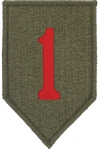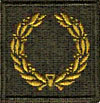
|
|
||||||||||||||||||||||
|
||||||||||||||||||||||
|
||||||||||||||||||||||
|
||||||||||||||||||||||
|
||||||||||||||||||||||
|
Actors who served in WWII |
||||||||||||||||
| I love watching military movies and Memorial Day and D-Day got me thinking. I know there were a lot of actors that were in the military during WWII but I had no idea how many there were or what they had done. I did some research and this is what I have so far. Some of the actions are very impressive. You might be surprised by some of the names you see on this list, in alphabetical order, of great men and women. The picture on the left is their military picture (if I could find one). So far I have 126 actors listed and searching for more. | ||||||||||||||||
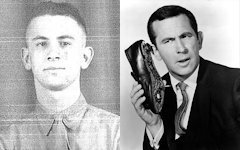 |
 |
Don Adams USMC Corporal 1942-1945 |
 Born Donald James Yarmy,
Adams served as a rifleman in India Company, 3rd Battalion, 8th Marine Regiment. He was wounded and almost dies in the Battle of Guadalcanal. He was the only survivor
of his platoon. He then contracted blackwater fever due to malaria and was hospitalized for more than a year in New Zealand. After his recovery, he was sent back to
the States and he served as a Marine Drill Instructor. Born Donald James Yarmy,
Adams served as a rifleman in India Company, 3rd Battalion, 8th Marine Regiment. He was wounded and almost dies in the Battle of Guadalcanal. He was the only survivor
of his platoon. He then contracted blackwater fever due to malaria and was hospitalized for more than a year in New Zealand. After his recovery, he was sent back to
the States and he served as a Marine Drill Instructor.He was awarded the Purple Heart, Navy and Marine Corps Commendation Medal with Bronze V device, Combat Action Ribbon, Navy Presidential Unit Citation, Marine Corps Good Conduct Medal, American Campaign Medal, Asiatic-Pacific Campaign Medal with 1 Bronze Battle Star, World War II Victory Medal, Rifle Expert Badge, USMC Basic Qualification Badge, and the Honorable Discharge Pin. |
|||||||||||||
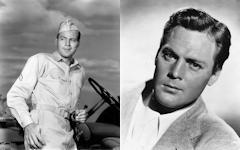 |
 |
John Agar US Army Air Forces Sergeant 1942-1946 |
 Joined the Navy Air Corps in 1941 as a
Physical Training Instructor and was discharged in 1943 due to an ear infection. He then enlisted in the US Army Air Forces as a Physical Training Instructor. Joined the Navy Air Corps in 1941 as a
Physical Training Instructor and was discharged in 1943 due to an ear infection. He then enlisted in the US Army Air Forces as a Physical Training Instructor.He was awarded the Army Good Conduct Medal, American Campaign Medal, and the World War II Victory Medal. |
|||||||||||||
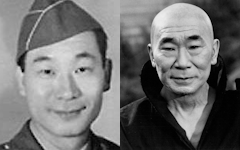 |
Philip Ahn US Army Sergeant 1941-1945 |
 Enlisted in the United States Army and served
in the Special Services as an entertainer. He was discharged early because of an injured ankle and returned to making films. Enlisted in the United States Army and served
in the Special Services as an entertainer. He was discharged early because of an injured ankle and returned to making films.He was awarded the World War II Victory Medal. |
||||||||||||||
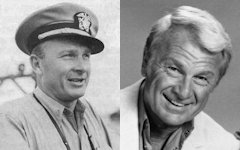 |
 |
Eddie Albert US Navy Lieutenant 1942-1945 |
 Prior to the war, Albert worked for Army Intelligence photographing German U-boats
while working in Mexico. In 1942, he enlisted in the US Coast Guard and was discharged in 1943 to accept a commission in the US Navy. During the invasion of Tarawa,
as the Coxswain of a landing craft, he rescued 47 Marines that were wounded and supervised the rescue of 30 others during 26 rescue missions. Prior to the war, Albert worked for Army Intelligence photographing German U-boats
while working in Mexico. In 1942, he enlisted in the US Coast Guard and was discharged in 1943 to accept a commission in the US Navy. During the invasion of Tarawa,
as the Coxswain of a landing craft, he rescued 47 Marines that were wounded and supervised the rescue of 30 others during 26 rescue missions.He was awarded the Bronze Star with Combat "V" device, American Campaign Medal, Asiatic Pacific Campaign Medal, and the World War II Victory Medal. |
|||||||||||||
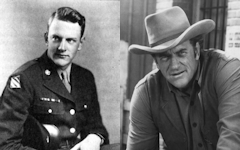 |
 |
James Arness US Army Corporal 1943-1945
|
 A rifleman in 2nd Platoon, Company E, 2nd Battalion,
7th Infantry, on January 25, 1944, he received his "baptism of fire" when he was almost killed by enemy 20 mm flak wagon fire during a night patrol behind enemy lines.
A few days later, Arness was involved in a sustained firefight with enemy machine gunners occupying a farmhouse. Ultimately, the enemy brought mortar fire down on
Arness and his squad, which were lying low in a shallow drainage ditch filled with water. One mortar round hit within a few feet of Arness, killing the infantryman to
his left. Heavy artillery then pinned down 2nd Platoon until nightfall. Using darkness to mask their escape the platoon quietly and quickly made their way back to
their lines. A rifleman in 2nd Platoon, Company E, 2nd Battalion,
7th Infantry, on January 25, 1944, he received his "baptism of fire" when he was almost killed by enemy 20 mm flak wagon fire during a night patrol behind enemy lines.
A few days later, Arness was involved in a sustained firefight with enemy machine gunners occupying a farmhouse. Ultimately, the enemy brought mortar fire down on
Arness and his squad, which were lying low in a shallow drainage ditch filled with water. One mortar round hit within a few feet of Arness, killing the infantryman to
his left. Heavy artillery then pinned down 2nd Platoon until nightfall. Using darkness to mask their escape the platoon quietly and quickly made their way back to
their lines.Later his squad engaged an enemy machine gun in a farmhouse. Upon entering the house Arness and two other rifleman crept up the steps, and threw grenades into the room with the machine gun. Once the grenades exploded, Arness and the others rushed the room and sprayed the enemy with rifle fire, killing the three-man gun crew. On the night of February 1, 1944, 2nd Platoon (with Arness) was assigned to reconnoiter a sector between the lines. There was no moon. The platoon spread out to minimize casualties and advanced slowly, under direct orders not to speak or make a sound. Due to his night combat experience and a 'sixth sense' Arness was the point man for his squad. Moving silently as possible, approximately 40 to 50 feet ahead of his squad, Arness would later say that it was so dark that he could not see his feet or where he was stepping. After walking approximately 20 minutes there was no contact and except for the night sounds, the air was quiet. Arness moved through a small vineyard. Suddenly he heard voices just 50 feet ahead. Seconds later Arness heard a 'guttural scream' and an enemy machine gun fired, hitting Arness in the right leg with a machine gun bullet. Despite the excruciating pain (he later said the bones in his lower right leg 'had been shot all to hell') he was able to leap over a row of vines, and out of the line of fire. Now intense enemy fire was directed at him from both sides. Then an enemy 'potato masher' concussion grenade went off near him, the explosion literally lifting Arness off the ground. Arness hugged the earth as enemy machine gunfire racked around him, just 18-inches above the ground. After an intense firefight, the enemy was eventually beaten back or eliminated by the rest of 2nd Platoon. While lying in the vineyard, Arness felt he was going into shock. In a semi-conscious state he heard voices, realizing it was soldiers from his own platoon checking on the wounded and dead. The point man next to Arness had been killed, as well as several others. Finally a medic found Arness and asked if he had been hit. Arness responded, 'In the leg' and realized he could not move. The medic said the leg bones had been severely splintered. Treating the wound with sulfa powder, the medic administered a shot of morphine directly into Arness' stomach. The medic then declared the wound or Zone of Interior wound, (aka Million Dollar Wound), which meant an eventual ticket stateside. On January 29, 1945, having received numerous surgeries, Arness received an honorable discharge. He fought at the Naples-Foggia Campaign, and the Anzio Campaign. He was awarded the Bronze Star with V device, Purple Heart, American Campaign Medal, European-African-Middle Eastern Campaign Medal with 4 Bronze Battle Stars and 1 Bronze Arrowhead device, World War II Victory Medal, Combat Infantryman Badge, Expert Marksman Badge with Rifle device, and the Honorable Discharge Pin. |
|||||||||||||
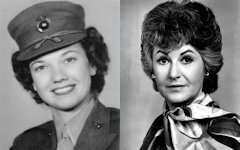 |
 |
Bea Arthur USMC Staff Sergeant 1943-1945 |
 Born Bernice Frankel, Arthur
enlisted as one of the first members of the United States Marine Corps Women's Reserve. She served as a typist at Marine Headquarters in Washington, DC. She
then transferred to the Motor Transport School, Camp Lejeune, NC and later worked as a truck driver and dispatcher in Cherry Point, NC. Born Bernice Frankel, Arthur
enlisted as one of the first members of the United States Marine Corps Women's Reserve. She served as a typist at Marine Headquarters in Washington, DC. She
then transferred to the Motor Transport School, Camp Lejeune, NC and later worked as a truck driver and dispatcher in Cherry Point, NC.She was awarded the American Campaign Medal, World War II Victory Medal, and the Honorable Discharge Pin. |
|||||||||||||
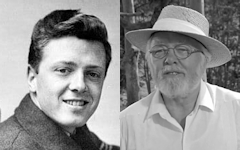 |
Richard Attenborough Royal Air Force Sergeant 1940-1945 |
 Served in the Royal Air Force and after
initial pilot training, he was assigned to the newly formed Royal Air Force Film Production Unit at Pinewood Studios. He appeared with Edward G. Robinson in the
propaganda film Journey Together (1943). He then volunteered to fly with the Film Unit and after further training, where he sustained permanent ear damage, he
qualified as a sergeant, flying on several missions over Europe filming from the rear gunner's position to record the outcome of RAF Bomber Command sorties. Served in the Royal Air Force and after
initial pilot training, he was assigned to the newly formed Royal Air Force Film Production Unit at Pinewood Studios. He appeared with Edward G. Robinson in the
propaganda film Journey Together (1943). He then volunteered to fly with the Film Unit and after further training, where he sustained permanent ear damage, he
qualified as a sergeant, flying on several missions over Europe filming from the rear gunner's position to record the outcome of RAF Bomber Command sorties.He was awarded the 1939–1945 Star, Air Crew Europe Star, and the War Medal 1939–1945. |
||||||||||||||
 |
 |
Gene Autry US Army Air Forces Flight Officer 1942-1946
|
 Enlisted in the US Army in 1942
and was transferred to the US Army Air Forces as a tech sergeant. Since he already had a private pilot's license, he was determined to become a military pilot
and earned his Service Pilot rating in 1944. Autry flew C-109 transport planes at the rank of Flight Officer and was assigned to the Air Transport Command. He
flew as part of the dangerous airlift operation over the Himalayas between India and China. Enlisted in the US Army in 1942
and was transferred to the US Army Air Forces as a tech sergeant. Since he already had a private pilot's license, he was determined to become a military pilot
and earned his Service Pilot rating in 1944. Autry flew C-109 transport planes at the rank of Flight Officer and was assigned to the Air Transport Command. He
flew as part of the dangerous airlift operation over the Himalayas between India and China.He was awarded the Army Good Conduct Medal, American Campaign Medal, the Asiatic-Pacific Campaign Medal, and the World War II Victory Medal. |
|||||||||||||
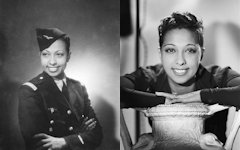 |
Josephine Baker French Resistance Spy 1939-1945 |
 Recruited by the Deuxième Bureau, the
French Military Intelligence Agency in 1939. She collected information about German troop locations from officials she met at parties and gatherings
at embassies and ministries. In southern France, she housed people wanting to help the French and supplied them with visas. She used invisible ink
to write notes on her sheet music. Recruited by the Deuxième Bureau, the
French Military Intelligence Agency in 1939. She collected information about German troop locations from officials she met at parties and gatherings
at embassies and ministries. In southern France, she housed people wanting to help the French and supplied them with visas. She used invisible ink
to write notes on her sheet music.She was awarded the Chevalier of the Légion d'Honneur, Croix de Guerre, and the Rosette de la Résistance, by General Charles de Gaulle. |
||||||||||||||
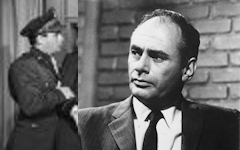 |
 |
Martin Balsam US Army Air Forces Sergeant 1941-1945 |
 Served as a combat engineer
with the Army and then as a B-24 Radio Operator in the China-Burma-India theater of operations. Served as a combat engineer
with the Army and then as a B-24 Radio Operator in the China-Burma-India theater of operations.He was awarded the American Defense Service Medal, American Campaign Medal, World War II Victory Medal, and the Honorable Discharge Pin. |
|||||||||||||
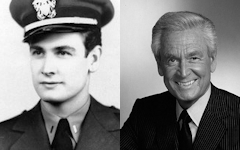 |
 |
Bob Barker US Navy Lieutenant JG 1942-1945 |
 Baker was commissioned as an Ensign in
the United States Navy two and a half years after he had to have completed two years of college to qualify to become a naval aviation cadet. He reported for
active duty on June 9, 1943. Over the course of eighteen months, he trained at eight different wartime locations and flew eight different airplanes, including
the legendary Corsair. Baker was commissioned as an Ensign in
the United States Navy two and a half years after he had to have completed two years of college to qualify to become a naval aviation cadet. He reported for
active duty on June 9, 1943. Over the course of eighteen months, he trained at eight different wartime locations and flew eight different airplanes, including
the legendary Corsair.His Navy training began at William Jewell College in Liberty, MO, just outside of Kansas City. He was a member of the Sixth Battalion at William Jewell. His first taste of flying came at the next training base, which was in Ames, Iowa, at Iowa State University. At this location he had Civilian Flight Instructors and he learn to fly and solo at age 19 in a Taylorcraft Plane. He was then transferred to the University of Georgia for preflight school. After preflight, he went to Millington Naval Air Station just outside of Memphis, TN, where he went to official Navy flight training. This included night and formation flying. At the Memphis base, Barker was trained to fly the Steamian, which was a biplane and an open cockpit. His next wartime duty station was the huge naval air station at Corpus Christi, TX, where he completed his flight training and was commissioned as an Ensign. He had the Commanding Officer pin his gold wings on his chest. His was then assigned to Cabaniss Field for basic and was flying the BT-13. Next, he trained to be a fighter pilot. He was sent to the field at Beeville for instrument training. At Beeville he flew the SNJ, an even more powerful plane than the BT-13. The SNJ was a trainer that was the closest thing to a fighter. Advanced training was next, and supposedly it was the last hurdle before graduation. He went to Waldron Field for advanced and it included dogfighting, this time flying the SNJ. He was then sent to Preoperational training using the SDB Dive Bomber for a few weeks. Finally he was sent to Operational Training at DeLand, FL, to fly FM-2 Fighters. He was also sent to the Great Lakes Naval Air Station to do twelve qualifying carrier landings on the Wolverine (a carrier kept at Lake Michigan), and he was one of those who received a grade of superior. He was finally sent to Banana River Naval Air Station, expecting to be assigned to a carrier squadron but instead was one of seven pilots responsible for flying out over the Atlantic and make gunnery runs on US Navy Mariner aircraft for testing the Mariners crew. He was transferred again to learn to fly F4U Corsairs in Goose Isle, MI, and logged a few hours in the seat but the war was coming to end. As he once said "I was a naval aviator, a fighter pilot. I completed all facets of my training, including my qualifying landings on a carrier. I was all ready to go, and when the enemy heard that I was headed for the Pacific, they surrendered. That was the end of World War II." He was awarded the American Campaign Medal, World War II Victory Medal, and the Naval Aviator Badge. |
|||||||||||||
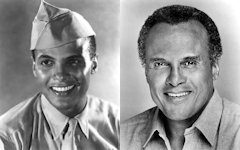 |
 |
Harry Belafonte US Navy Seaman Second Class 1943-1945 |
 Belafonte served in the Navy from
1943-1945. Belafonte served in the Navy from
1943-1945.He was awarded the American Campaign Medal, and the World War II Victory Medal. |
|||||||||||||
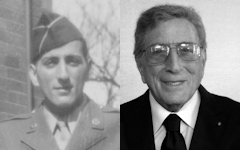 |
 |
Tony Bennett US Army Corporal 1944-1946
|
 Drafted into the Army in 1944 and served as
an infantry rifleman in the 63rd Infantry Division, 255th Infantry Regiment, a unit filling in after the Battle of the Bulge. He started in France in January
1945 and by March, had made it to Germany to fight on the front line. He was involved in the liberation of the Nazi concentration camp at Landsberg and later
stayed in Germany to sing with the 314th Army Special Services Band. Drafted into the Army in 1944 and served as
an infantry rifleman in the 63rd Infantry Division, 255th Infantry Regiment, a unit filling in after the Battle of the Bulge. He started in France in January
1945 and by March, had made it to Germany to fight on the front line. He was involved in the liberation of the Nazi concentration camp at Landsberg and later
stayed in Germany to sing with the 314th Army Special Services Band.He was awarded the American Campaign Medal, European-African-Middle Eastern Campaign Medal with 2 Bronze Battle Stars, World War II Victory Medal, Army of Occupation Medal, and the Honorable Discharge Pin. |
|||||||||||||
 |
 |
Yogi Berra US Navy Gunner's Mate Seaman First Class 1943-1946 |
 Served aboard the USS Bayfield (APA-33) and was part
of a 6 man team on Landing Craft Support Small (LCSS) Rocket Launcher boats armed with 6 twin-fifty machine guns and 12 rockets. During the landing at Omaha Beach on
D-Day, the LCSS boats went in before the rest of the landing craft to soften the German defenses for the troops wading ashore behind them and then headed to shore.
He also spent time on Utah Beach. For two weeks, they patrolled the English Channel and were then sent to Yellow Beach. He was shot in the hand by a German machine
gunner just before his crew launched their rockets and blew up the machine gun nest. Served aboard the USS Bayfield (APA-33) and was part
of a 6 man team on Landing Craft Support Small (LCSS) Rocket Launcher boats armed with 6 twin-fifty machine guns and 12 rockets. During the landing at Omaha Beach on
D-Day, the LCSS boats went in before the rest of the landing craft to soften the German defenses for the troops wading ashore behind them and then headed to shore.
He also spent time on Utah Beach. For two weeks, they patrolled the English Channel and were then sent to Yellow Beach. He was shot in the hand by a German machine
gunner just before his crew launched their rockets and blew up the machine gun nest.He was awarded the Purple Heart, Combat Action Ribbon, Navy Presidential Unit Citation, Navy Good Conduct Medal, European-African-Middle Eastern Campaign Medal with 1 Bronze Battle Star, World War II Victory Medal, and the Honorable Discharge Pin. |
|||||||||||||
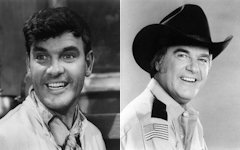 |
 |
James Best US Army Air Forces Corporal 1944-1945
|
 Trained as a gunner on a B-17 but by
the time his training was over, the war had almost ended. He then served an an MP in Germany after the Nazi surrender. Later, he transferred to the Special
Services unit and traveled around Europe entertaining troops. Trained as a gunner on a B-17 but by
the time his training was over, the war had almost ended. He then served an an MP in Germany after the Nazi surrender. Later, he transferred to the Special
Services unit and traveled around Europe entertaining troops.He was awarded the American Campaign Medal, World War II Victory Medal, Army of Occupation Medal, and the Aerial Gunner Badge. |
|||||||||||||
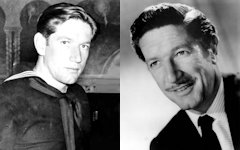 |
 |
Richard Boone US Navy Aviation Ordnanceman Petty Officer First Class 1942-1945 |
 Boone was first transported aboard the USS Prince
William (AVG-31) leaving San Diego on June 14, 1943. He arrived sometime after that at Naval Air Station Maui, Hawaii. On June 29, 1943, the squadron was transported
from NAS Maui to NAS Pearl Harbor for departure on an aircraft carrier. On November 5, 1943, he was transported from Maui to Pearl Harbor for assignment to the USS
Intrepid (CV-11). He was then on the USS White Plains (CVE-66) on February 25, 1944 to head back to Pearl Harbor. He served as an aircrewman and tail gunner on Grumman
TBF Avenger torpedo bombers. Boone was first transported aboard the USS Prince
William (AVG-31) leaving San Diego on June 14, 1943. He arrived sometime after that at Naval Air Station Maui, Hawaii. On June 29, 1943, the squadron was transported
from NAS Maui to NAS Pearl Harbor for departure on an aircraft carrier. On November 5, 1943, he was transported from Maui to Pearl Harbor for assignment to the USS
Intrepid (CV-11). He was then on the USS White Plains (CVE-66) on February 25, 1944 to head back to Pearl Harbor. He served as an aircrewman and tail gunner on Grumman
TBF Avenger torpedo bombers.He was awarded the Combat Action Ribbon, American Campaign Medal, Asiatic-Pacific Campaign Medal with 4 Bronze Battle Stars, World War II Victory Medal, and the Honorable Discharge Pin. Richard Boone was buried at sea in the Pacific Ocean. |
|||||||||||||
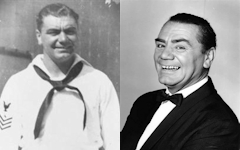 |
  |
Ernest Borgnine US Navy Gunner's Mate Petty Officer First Class 1935-1945 |
 Joined the Navy in 1935 and served aboard the USS
Lamberton (DD-119). Operating out of San Diego, the ship towed targets for surface combatants, submarines and aircraft and experimented with minesweeping exercises.
The Lamberton would be redesignated as DMS-1 (minesweeper, destroyer) in November 1940. Borgnine was discharged in October, 1941. In January, 1942, he reenlisted
after the attack on Pearl Harbor. He served aboard the USS Sylph (PY-12), a converted yacht devoted to antisubmarine warfare. Operating first out of New York and
then Connecticut, the Sylph patrolled the Atlantic Coast searching for German U-boats. In 1943, the Sylph was transferred to Rhode Island and in 1944 to Florida. Joined the Navy in 1935 and served aboard the USS
Lamberton (DD-119). Operating out of San Diego, the ship towed targets for surface combatants, submarines and aircraft and experimented with minesweeping exercises.
The Lamberton would be redesignated as DMS-1 (minesweeper, destroyer) in November 1940. Borgnine was discharged in October, 1941. In January, 1942, he reenlisted
after the attack on Pearl Harbor. He served aboard the USS Sylph (PY-12), a converted yacht devoted to antisubmarine warfare. Operating first out of New York and
then Connecticut, the Sylph patrolled the Atlantic Coast searching for German U-boats. In 1943, the Sylph was transferred to Rhode Island and in 1944 to Florida.
He was awarded the Navy Good Conduct Medal with 2 Bronze Stars, American Defense Service Medal with Fleet Clasp, American Campaign Medal, World War II Victory Medal, and the Honorable Discharge Pin. |
|||||||||||||
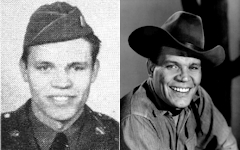 |
 |
Neville Brand US Army Staff Sergeant 1939-1945
|
 Served in 2nd Battalion, 129th Infantry Regiment
as a Platoon Leader in the Ardennes, Rhineland. He was awarded the Silver Star when his unit was pinned down by Germans firing machine guns from a hunting lodge and
he went in to the lodge and killed all the Germans inside. On April 7, 1945, Brand was shot in the arm and almost bled to death. He was rescued and transported to
a hospital and in September, he departed for the US and discharged a month later. He fought at the Rhineland Campaign, Ardennes Alsace Campaign, and the Central Europe
Campaign. Served in 2nd Battalion, 129th Infantry Regiment
as a Platoon Leader in the Ardennes, Rhineland. He was awarded the Silver Star when his unit was pinned down by Germans firing machine guns from a hunting lodge and
he went in to the lodge and killed all the Germans inside. On April 7, 1945, Brand was shot in the arm and almost bled to death. He was rescued and transported to
a hospital and in September, he departed for the US and discharged a month later. He fought at the Rhineland Campaign, Ardennes Alsace Campaign, and the Central Europe
Campaign.He was awarded the Silver Star, Purple Heart, Army Good Conduct Medal, American Defense Service Medal, European-African-Middle Eastern Campaign Medal with three Battle Stars, World War II Victory Medal, Combat Infantryman Badge, one Overseas Service Bar, one Service Stripe, and the Honorable Discharge Pin. |
|||||||||||||
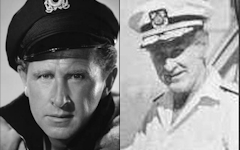 |
 |
Lloyd Bridges US Coast Guard District Commodore 1942-1962 |
 Bridges left Hollywood to
join the Coast Guard. After the war, he did several public service announcements for the Coast Guard and was made an honorary District Commodore. Bridges left Hollywood to
join the Coast Guard. After the war, he did several public service announcements for the Coast Guard and was made an honorary District Commodore.He was awarded the World War II Victory Medal. |
|||||||||||||
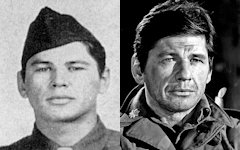 |
 |
Charles Bronson US Army Air Forces Sergeant 1943-1946
|
 Served in the
760th Flexible Gunnery Training Squadron and in 1945, served in the 61st Bombardment Squadron, 39th Bombardment Group as a B-29 Superfortress aerial
gunner. He flew 25 combat missions against the Japanese home islands. Served in the
760th Flexible Gunnery Training Squadron and in 1945, served in the 61st Bombardment Squadron, 39th Bombardment Group as a B-29 Superfortress aerial
gunner. He flew 25 combat missions against the Japanese home islands.He was awarded the Purple Heart, Army Air Medal, Army Presidential Unit Citation, Army Good Conduct Medal, American Campaign Medal, Asiatic-Pacific Campaign Medal with 1 Bronze Battle Star, World War II Victory Medal, Expert Marksman with Aeroweapons Badge, and the Sharpshooter Marksman with Pistol Badge. |
|||||||||||||
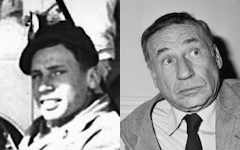 |
 |
Mel Brooks US Army Corporal 1944-1946 |
 Enlisted into the Army in
1944, Brooks was originally sent to the elite Army Specialized Training Program and the Virginia Military Institute. When the training program was closed
due to lack of manpower, Brooks went back to basic training. His first duty in Europe was a forward artillery observer. He then served as combat engineer
in the 1104th Engineer Combat Battalion, 78th Infantry Division where he defused land mines as the Allies advanced towards Germany. They also built bridges
and destroyed pill boxes. He fought in the Battle of the Bulge. When the war came to an end in Europe, he organized shows for American forces as well as
captured Germans. Enlisted into the Army in
1944, Brooks was originally sent to the elite Army Specialized Training Program and the Virginia Military Institute. When the training program was closed
due to lack of manpower, Brooks went back to basic training. His first duty in Europe was a forward artillery observer. He then served as combat engineer
in the 1104th Engineer Combat Battalion, 78th Infantry Division where he defused land mines as the Allies advanced towards Germany. They also built bridges
and destroyed pill boxes. He fought in the Battle of the Bulge. When the war came to an end in Europe, he organized shows for American forces as well as
captured Germans.He was awarded the American Campaign Medal, European-African-Middle Eastern Campaign Medal with 1 Bronze Battle Stars, World War II Victory Medal, and the Honorable Discharge Pin. |
|||||||||||||
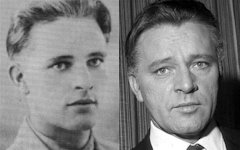 |
Richard Burton Royal Air Force Aircraftman First Class 1944-1947 |
 Served in the RAF as a Navigator and
later as an Instructor in Canada. Served in the RAF as a Navigator and
later as an Instructor in Canada.He was awarded the 1939–1945 Star, Air Crew Europe Star, and the War Medal 1939–1945. |
||||||||||||||
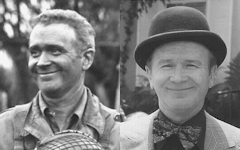 |
 |
Red Buttons US Army Air Forces Second Lieutenant 1943-1945 |
 Buttons was drafted into
the Army Air Corps and entertained US troops in Europe. He was cast in Moss Hart's wartime propaganda play "Winged Victory". Buttons was drafted into
the Army Air Corps and entertained US troops in Europe. He was cast in Moss Hart's wartime propaganda play "Winged Victory".He was awarded the American Campaign Medal, European-African-Middle Eastern Campaign Medal, World War II Victory Medal, and the Sharpshooter Marksman with Carbine Badge. |
|||||||||||||
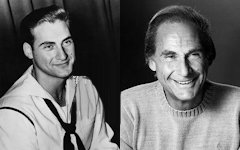 |
 |
Sid Caesar US Coast Guard Musician Petty Officer Third Class 1939-1945 |
 Caesar joined the Coast Guard in
1939, after studying saxophone at the Julliard School of Music and playing in a number of prominent big bands. In the Coast Guard, he was assigned to play in
military revues and shows, such as "Tars and Spars," but he showed a natural penchant for comedy by entertaining other band members with his improvised routines,
prompting show producer Max Liebman to move him from the orchestra and cast him as a stand-up comedian to entertain troops. Caesar joined the Coast Guard in
1939, after studying saxophone at the Julliard School of Music and playing in a number of prominent big bands. In the Coast Guard, he was assigned to play in
military revues and shows, such as "Tars and Spars," but he showed a natural penchant for comedy by entertaining other band members with his improvised routines,
prompting show producer Max Liebman to move him from the orchestra and cast him as a stand-up comedian to entertain troops.He was awarded the US Coast Guard Good Conduct Medal, American Defense Service Medal, American Campaign Medal, World War II Victory Medal, and the Honorable Discharge Pin. |
|||||||||||||
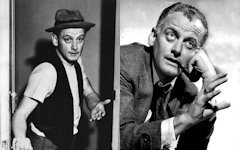 |
Art Carney US Army Private 1943-1945
|
 Drafted into the Army in
1943 as an infantryman and machinegunner. He served in the 28th Infantry Division and was wounded in the leg by shrapnel at Normandy. Because of the
injury, his right leg was 3/4 of an inch shorter than his left which caused him to walk with a limp for the rest of his life. Drafted into the Army in
1943 as an infantryman and machinegunner. He served in the 28th Infantry Division and was wounded in the leg by shrapnel at Normandy. Because of the
injury, his right leg was 3/4 of an inch shorter than his left which caused him to walk with a limp for the rest of his life.He was awarded the Purple Heart, Meritorious Unit Commendation, American Campaign Medal, European–African–Middle Eastern Campaign Medal, and the World War II Victory Medal. |
||||||||||||||
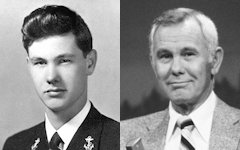 |
 |
Johnny Carson US Navy Ensign 1943-1946 |
 Joined the Navy in 1943 and was entered
into the V-5 Navy College Training Program for officer training at Columbia University and later at Millsap College. Assigned to the USS Pennsylvania
(BB-38) in the Pacific as a Communications Officer decoding encrypted messages. He was en route to the combat zone aboard a troop ship when the war
ended. The Pennsylvania was torpedoed 2 days before he reported for duty and sailed to Guam for repairs. As the newest officer aboard, he had to
supervise the removal of the 20 killed in action. Joined the Navy in 1943 and was entered
into the V-5 Navy College Training Program for officer training at Columbia University and later at Millsap College. Assigned to the USS Pennsylvania
(BB-38) in the Pacific as a Communications Officer decoding encrypted messages. He was en route to the combat zone aboard a troop ship when the war
ended. The Pennsylvania was torpedoed 2 days before he reported for duty and sailed to Guam for repairs. As the newest officer aboard, he had to
supervise the removal of the 20 killed in action.He was awarded the American Campaign Medal, Asiatic-Pacific Campaign Medal, and the World War II Victory Medal. |
|||||||||||||
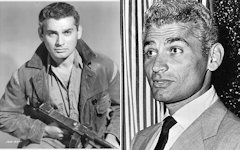 |
 |
Jeff Chandler US Army Captain 1941-1945 |
 Enlisted in the Army in 1941, and served
mostly in the Aleutians. Enlisted in the Army in 1941, and served
mostly in the Aleutians.He was awarded the American Defense Service Medal, American Campaign Medal, and the World War II Victory Medal. |
|||||||||||||
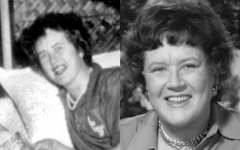 |
Julia Child OSS 1942-1945 |
 Joined the Office of Strategic
Services when she found out she was too tall to enlist in the Women's Army Corps (WACs) or in the US Navy's WAVES. She served as a typist in Washington
DC but due to her education and experience, she was transferred to a top-secret research assistant position reporting directly to the head of the OSS.
While in the Secret Intelligence Division, she typed 10,000 names on white note cards to keep track of officers. For a year, she worked at the OSS
Emergency Sea Rescue Equipment Section as a file clerk. She was responsible for registering, cataloging and channeling a great volume of highly classified
communications for the OSS's clandestine stations in Asia. She was then asked to help solve a problem of too many OSS explosives being set off by sharks.
Her solution was to experiment with cooking up various concoctions of "shark repellent" which was sprinkled in the water near the explosives to repel
sharks. It is still in use today. Joined the Office of Strategic
Services when she found out she was too tall to enlist in the Women's Army Corps (WACs) or in the US Navy's WAVES. She served as a typist in Washington
DC but due to her education and experience, she was transferred to a top-secret research assistant position reporting directly to the head of the OSS.
While in the Secret Intelligence Division, she typed 10,000 names on white note cards to keep track of officers. For a year, she worked at the OSS
Emergency Sea Rescue Equipment Section as a file clerk. She was responsible for registering, cataloging and channeling a great volume of highly classified
communications for the OSS's clandestine stations in Asia. She was then asked to help solve a problem of too many OSS explosives being set off by sharks.
Her solution was to experiment with cooking up various concoctions of "shark repellent" which was sprinkled in the water near the explosives to repel
sharks. It is still in use today.She was awarded the Meritorious Civilian Service Award. |
||||||||||||||
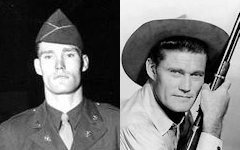 |
 |
Chuck Connors US Army Sergeant 1941-1945 |
 Joined the Army in 1942 and
served as a tank-warfare instructor at Fort Campbell, Kentucky, and later at West Point in New York. Joined the Army in 1942 and
served as a tank-warfare instructor at Fort Campbell, Kentucky, and later at West Point in New York.He was awarded the Army Good Conduct Medal, American Campaign Medal, World War II Victory Medal, and the Honorable Discharge Pin. |
|||||||||||||
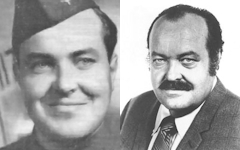 |
 |
William Conrad US Army Air Forces Captain 1943-1946 |
 Born John William
Cann, Jr., Conrad joined the Army Air Forces and trained as a fighter pilot with the 37th Flying Training Wing. He would later transfer to the Armed Forces
Radio and Television Service as a producer/director. Born John William
Cann, Jr., Conrad joined the Army Air Forces and trained as a fighter pilot with the 37th Flying Training Wing. He would later transfer to the Armed Forces
Radio and Television Service as a producer/director.He was awarded the American Campaign Medal, European-African-Middle Eastern Campaign Medal with 1 Bronze Battle Star, World War II Victory Medal, Pilot Badge, and the Honorable Discharge Pin. |
|||||||||||||
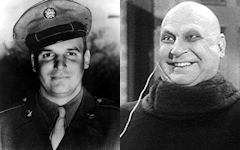 |
 |
Jackie Coogan US Army Air Forces Second Lieutenant 1941-1945
|
 Enlisted in the Army in March,
1941. After the attack at Pearl Harbor, he asked to be transferred to the Army Air Forces due to his civilian flying experience. After graduating Advanced
Glider School with a rating of Glider Pilot and the rank of Flight Officer, he volunteered for hazardous duty with the 1st Air Commando Group. In December
1943, his unit was sent to India where he flew British troops landing them at night in a small jungle clearing 100 miles behind Japanese lines in the Burma
Campaign. He returned to the US in May 1944 and was discharged in December 1945. Enlisted in the Army in March,
1941. After the attack at Pearl Harbor, he asked to be transferred to the Army Air Forces due to his civilian flying experience. After graduating Advanced
Glider School with a rating of Glider Pilot and the rank of Flight Officer, he volunteered for hazardous duty with the 1st Air Commando Group. In December
1943, his unit was sent to India where he flew British troops landing them at night in a small jungle clearing 100 miles behind Japanese lines in the Burma
Campaign. He returned to the US in May 1944 and was discharged in December 1945.He was awarded the Army Air Medal, Army Presidential Unit Citation, Army Good Conduct Medal, American Defense Service Medal, American Campaign Medal, Asiatic-Pacific Campaign Medal with 3 Bronze Battle Stars, World War II Victory Medal, and the Glider Pilot Badge. |
|||||||||||||
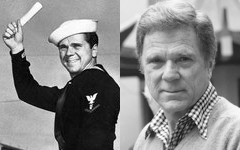 |
 |
Jackie Cooper US Navy Captain 1943-1946 1961-1982 |
 Cooper joined the Navy in 1943 as a
musician and played drums in and The Band of the US Navy Liberation Forces with former civilian bandleader Claude Thornhill. They played bases in the South
Pacific. After the war, Cooper went back to Hollywood and in 1961, he accepted a commission with the Naval Reserves as a line officer with duties in
recruitment, training films and public relations. Since he already had a multi-engine pilot's license, he would go on to co-pilot jets for the Navy which
made him Honorary Aviator authorized to wear Naval Aviator Wings. At the time, he was only the third person in Naval aviation history to do so. In 1976, he
was promoted to Captain and was in uniform aboard the carrier USS Constellation (CV-64) for the Bicentennial celebration on July 4. In 1980 the Navy proposed
a period of active duty at the Pentagon which would have resulted in a promotion to Rear Admiral, bringing him even with Air Force Reserve Brigadier General
James Stewart. Fresh on the heels of a second directing Emmy, he felt his absence would impact achieving a long-held goal of directing motion pictures, and
reluctantly declined. He was given Letters of Commendation from six Secretaries of the Navy and was honorary chairman of the US Navy Memorial Foundation and
a charter member of VIVA, the effort to return POW-MIAs from Vietnam. Upon retirement in 1982 he was decorated with the Legion of Merit by Navy Secretary John
Lehman. Cooper joined the Navy in 1943 as a
musician and played drums in and The Band of the US Navy Liberation Forces with former civilian bandleader Claude Thornhill. They played bases in the South
Pacific. After the war, Cooper went back to Hollywood and in 1961, he accepted a commission with the Naval Reserves as a line officer with duties in
recruitment, training films and public relations. Since he already had a multi-engine pilot's license, he would go on to co-pilot jets for the Navy which
made him Honorary Aviator authorized to wear Naval Aviator Wings. At the time, he was only the third person in Naval aviation history to do so. In 1976, he
was promoted to Captain and was in uniform aboard the carrier USS Constellation (CV-64) for the Bicentennial celebration on July 4. In 1980 the Navy proposed
a period of active duty at the Pentagon which would have resulted in a promotion to Rear Admiral, bringing him even with Air Force Reserve Brigadier General
James Stewart. Fresh on the heels of a second directing Emmy, he felt his absence would impact achieving a long-held goal of directing motion pictures, and
reluctantly declined. He was given Letters of Commendation from six Secretaries of the Navy and was honorary chairman of the US Navy Memorial Foundation and
a charter member of VIVA, the effort to return POW-MIAs from Vietnam. Upon retirement in 1982 he was decorated with the Legion of Merit by Navy Secretary John
Lehman.He was awarded the Legion of Merit, Navy and Marine Corps Commendation Medal, Navy Distinguished Civilian Service Medal, Navy Good Conduct Medal, American Campaign Medal, Asiatic-Pacific Campaign Medal with 1 Bronze Battle Star, World War II Victory Medal, National Defense Service Medal, Naval Aviator Wings Badge, and the Honorable Discharge Pin. |
|||||||||||||
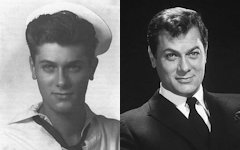 |
 |
Tony Curtis US Navy Signalman Petty Officer Third Class 1942-1945 |
 Enlisted in the US Navy after the
attack at Pearl Harbor and joined the Pacific submarine force. Served aboard the submarine tender, USS Proteus (AS-19), and on September 2, 1945, Curtis
witnessed the Japanese surrender in Tokyo Bay from his ship's signal bridge about a mile away. Enlisted in the US Navy after the
attack at Pearl Harbor and joined the Pacific submarine force. Served aboard the submarine tender, USS Proteus (AS-19), and on September 2, 1945, Curtis
witnessed the Japanese surrender in Tokyo Bay from his ship's signal bridge about a mile away.He was awarded the American Campaign Medal, Asiatic–Pacific Campaign Medal, World War II Victory Medal, and the Honorable Discharge Pin. |
|||||||||||||
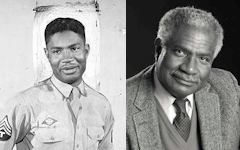 |
 |
Ossie Davis US Army Technician Fifth Grade 1942-1945 |
 Began his service as a surgical
technician in Liberia, West Africa with the 25th Surgical Hospital where he remained for almost 3 years. He then transferred to the Special Services unit where
he wrote and produced stage shows to entertain the troops. Began his service as a surgical
technician in Liberia, West Africa with the 25th Surgical Hospital where he remained for almost 3 years. He then transferred to the Special Services unit where
he wrote and produced stage shows to entertain the troops.He was awarded the Army Good Conduct Medal, American Campaign Medal, European-African-Middle Eastern Campaign Medal, World War II Victory Medal, and the Honorable Discharge Pin. |
|||||||||||||
 |
Sammy Davis Jr. US Army Private 1942-1945 |
 Rejected for overseas duty due to health reasons,
Davis served in the Special Services unit entertaining troops in the US. Rejected for overseas duty due to health reasons,
Davis served in the Special Services unit entertaining troops in the US.He was awarded the American Campaign Medal, World War II Victory Medal, and the Honorable Discharge Pin. |
||||||||||||||
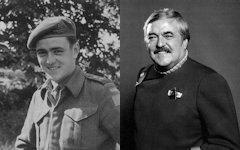 |
 |
James Doohan Royal Canadian Artillery Lieutenant |
 3rd Canadian Infantry
Division, 14th (Midland) Field Battery, landed on Juno Beach on D-Day killing 2 snipers. While crossing command posts, he was shot 6 times by a Canadian sentry,
4 in the legs, 1 in the chest (stopped by a silver cigarette case) and 1 in the finger that had to be amputated. Graduated Air Observation Pilot Course 40 and
flew Taylorcraft Auster Mark V aircraft for 666 (AOP) Squadron, RCAF as a Royal Canadian Artillery officer in support of 1st Army Group Royal Canadian Artillery. 3rd Canadian Infantry
Division, 14th (Midland) Field Battery, landed on Juno Beach on D-Day killing 2 snipers. While crossing command posts, he was shot 6 times by a Canadian sentry,
4 in the legs, 1 in the chest (stopped by a silver cigarette case) and 1 in the finger that had to be amputated. Graduated Air Observation Pilot Course 40 and
flew Taylorcraft Auster Mark V aircraft for 666 (AOP) Squadron, RCAF as a Royal Canadian Artillery officer in support of 1st Army Group Royal Canadian Artillery.He was awarded the 1939–1945 Star, France and Germany Star, Canadian Volunteer Service Medal with Overseas Bar, and the War Medal 1939–1945. |
|||||||||||||
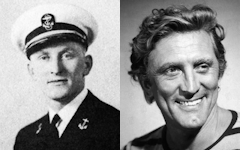 |
 |
Kirk Douglas US Navy Lieutenant JG 1941-1944 |
 Enlisted in the Navy in 1941 where he served
as a Gunnery and Communications Officer aboard the USS PC-1139, an anti-submarine warfare patrol ship. He was medically discharged for injuries sustained
from the premature explosion of a depth charge and it was discovered that he had chronic amoebic dysentery. Enlisted in the Navy in 1941 where he served
as a Gunnery and Communications Officer aboard the USS PC-1139, an anti-submarine warfare patrol ship. He was medically discharged for injuries sustained
from the premature explosion of a depth charge and it was discovered that he had chronic amoebic dysentery.He was awarded the American Campaign Medal, Asiatic-Pacific Campaign Medal, and the World War II Victory Medal. |
|||||||||||||
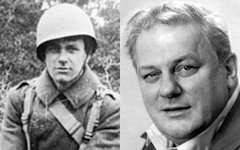 |
 |
Charles Durning US Army Private First Class 1943-1946
|
 Drafted into the Army, he was
first assigned as a rifleman with the 398th Infantry Regiment, and later served overseas with the 3rd Army Support troops and the 386th Anti-aircraft Artillery
(AAA) Battalion. Durning was then sent to the 1st Infantry Division and on June 6, 1944, he was one of the first troops to land on Omaha Beach and was the
only survivor of his unit to reach France. On June 15, he was wounded by a German "S" mine and was transported by the 499th Medical Collection Company to
the 24th Evacuation Hospital. By June 17 he was back in England at the 217th General Hospital. Although severely wounded by shrapnel in the left and right
thighs, the right hand, the frontal region of the head, and the anterior left chest wall, Durning recovered quickly and was determined to be fit for duty on
December 6, 1944. He arrived back at the front in time to take part in the Battle of the Bulge. After being wounded again, this time in the chest, Durning
was repatriated to the United States. He remained in Army hospitals to receive treatment for wounds until being discharged in 1946. Drafted into the Army, he was
first assigned as a rifleman with the 398th Infantry Regiment, and later served overseas with the 3rd Army Support troops and the 386th Anti-aircraft Artillery
(AAA) Battalion. Durning was then sent to the 1st Infantry Division and on June 6, 1944, he was one of the first troops to land on Omaha Beach and was the
only survivor of his unit to reach France. On June 15, he was wounded by a German "S" mine and was transported by the 499th Medical Collection Company to
the 24th Evacuation Hospital. By June 17 he was back in England at the 217th General Hospital. Although severely wounded by shrapnel in the left and right
thighs, the right hand, the frontal region of the head, and the anterior left chest wall, Durning recovered quickly and was determined to be fit for duty on
December 6, 1944. He arrived back at the front in time to take part in the Battle of the Bulge. After being wounded again, this time in the chest, Durning
was repatriated to the United States. He remained in Army hospitals to receive treatment for wounds until being discharged in 1946.He was awarded the Silver Star, Bronze Star, Purple Heart with 2 Bronze Oak Leaf Clusters, Army Good Conduct Medal, American Campaign Medal, European-African-Middle Eastern Campaign Medal with Arrowhead device and 2 Bronze Service Stars, World War II Victory Medal, French Legion of Honor, French Croix de Guerre, Combat Infantryman Badge, Meritorious Unit Commendation, French Fourragere, and the Honorable Discharge Pin. Charles Durning is buried at Arlington National Cemetery. |
|||||||||||||
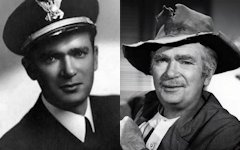 |
 |
Buddy Ebsen US Coast Guard Lieutenant 1941-1946 |
 Ebsen applied for a Navy commission in
1941 but was turned down even though he was teaching seamanship to Naval Reserve OCS candidates. He then applied for a commission with the Coast Guard and was
accepted and was commissioned as a Lieutenant JG. He served as the Executive Officer on the Navy frigate, USS Pocatello (PF-9). The ship was assigned to patrol
Weather Station Able about 1,500 miles west of Seattle, WA. Ebsen applied for a Navy commission in
1941 but was turned down even though he was teaching seamanship to Naval Reserve OCS candidates. He then applied for a commission with the Coast Guard and was
accepted and was commissioned as a Lieutenant JG. He served as the Executive Officer on the Navy frigate, USS Pocatello (PF-9). The ship was assigned to patrol
Weather Station Able about 1,500 miles west of Seattle, WA.He was awarded the American Campaign Medal, and the World War II Victory Medal. Buddy Ebsen was buried at sea in the Pacific Ocean. |
|||||||||||||
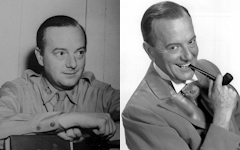 |
 |
Maurice Evans US Army Major 1942-1945 |
 Served as Commanding Officer, Army
Entertainment Section in the Central Pacific. The unit produced dozens of shows for the troops. Served as Commanding Officer, Army
Entertainment Section in the Central Pacific. The unit produced dozens of shows for the troops.He was awarded the American Campaign Medal, and the World War II Victory Medal. |
|||||||||||||
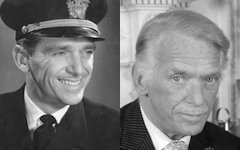 |
 |
Douglas Fairbanks Jr. US Navy Captain 1941-1946 |
 In 1941, Fairbanks was appointed by President
Roosevelt as a special envoy to South America where he gathered intelligence. Later that year he obtained a commission from the US Navy Reserves. He was then
assigned temporary duty in the Office of Naval Intelligence, Navy Department, Washington, D.C. Next he was ordered to the USS Ludlow (DD-438), serving as
assistant gunnery officer, assistant communication officer, and watch officer on the destroyer, which was part of a convoy escort in the North Atlantic. He
saw his first combat action against German U-boats in November 1941. He was then transferred as assistant gunnery and watch officer to the USS Mississippi
(BB-41), flagship of US Task Force 99, US Atlantic Fleet (attached to British Home Fleet) based in Reykjavik, Iceland, and Scapa Flow, Scotland. In 1941, Fairbanks was appointed by President
Roosevelt as a special envoy to South America where he gathered intelligence. Later that year he obtained a commission from the US Navy Reserves. He was then
assigned temporary duty in the Office of Naval Intelligence, Navy Department, Washington, D.C. Next he was ordered to the USS Ludlow (DD-438), serving as
assistant gunnery officer, assistant communication officer, and watch officer on the destroyer, which was part of a convoy escort in the North Atlantic. He
saw his first combat action against German U-boats in November 1941. He was then transferred as assistant gunnery and watch officer to the USS Mississippi
(BB-41), flagship of US Task Force 99, US Atlantic Fleet (attached to British Home Fleet) based in Reykjavik, Iceland, and Scapa Flow, Scotland.In January 1942, he served in the Office of Naval Intelligence, at headquarters of Commander-in-Chief, US Fleet, US Navy Department, Washington, D.C. In February, he served as Executive Officer with a minesweeper patrol in the US Atlantic coastal waters. In March, he was assigned to the staff of Commander, US Task Force 99 on the USS Washington (BB-56) as Flag Lieutenant and aide to the task force commander. In June, he was assigned temporary duty as assistant gunnery officer and “staff observer” on board the USS Wasp (CV-18) on convoys from Scapa Flow and Glasgow to Malta. In July, he was assigned the same duties onboard the heavy cruiser USS Wichita (CA-45) as part of close covering escort of Convoy PQ-17, from Scapa Flow, via the Arctic Ocean, to Murmansk, U.S.S.R. At the end of July through September, he was assigned to Rear Admiral Lord Louis Mountbatten’s Combined Operations Commando Headquarters, London. He participated in planning section, special weapons and camouflage sections, and attended the Commando Training Centre, Inverary, Scotland. Later he was assigned by Mountbatten to command a flotilla of amphibious raiding craft (only U.S. officer assigned), with bases in Warsash, and Isle of Wight. He operated with Royal Marine Commandos in raids across the English Channel. This is where he learned the art of naval deception and was then sent to Virginia Beach. Under the command of Adm. Hewitt, Fairbanks suggested that a unit of specialists that he had trained with might aid in the deployment of US Naval Forces in North Africa and the Mediterranean. In 1943, the Beach Jumper program began. The Beach Jumpers created and sustained the illusion that a military landing was happening at one beach, when in reality, that landing was taking place at a completely different location. These units had great success at Sicily, Salerno, Southern France, and the Philippines. He would go on to retire as a Captain in 1954. He was awarded the Silver Star, Legion of Merit with Bronze "V" device, American Defense Service Medal with Bronze "A" device, American Campaign Medal, European-African-Middle Eastern Campaign Medal with 1 Bronze Battle Star, World War II Victory Medal, French Légion d'honneur, French Croix de Guerre, and the US Navy Pistol Qualification Ribbon. |
|||||||||||||
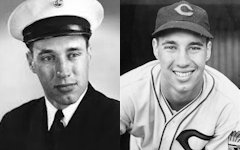 |
 |
Bob Feller US Navy Specialist (Athletics Instructor) Chief Petty Officer 1941-1945 |
 Bob Feller was one of the greatest pitchers to
ever play baseball and when he heard about the attack on Pearl Harbor, he was the first American professional athlete to enlist. He wanted to be a fighter pilot
but failed the hearing test. He served on the USS Alabama (BB-60) as a 40mm Gun Captain and as an athletics instructor. He fought at the Naval attack of Truk,
Operation Huskey, Operation Leader, Gilbert Islands Operation, Battle of Philippine Sea, and the Battle of Tinian. Bob Feller was one of the greatest pitchers to
ever play baseball and when he heard about the attack on Pearl Harbor, he was the first American professional athlete to enlist. He wanted to be a fighter pilot
but failed the hearing test. He served on the USS Alabama (BB-60) as a 40mm Gun Captain and as an athletics instructor. He fought at the Naval attack of Truk,
Operation Huskey, Operation Leader, Gilbert Islands Operation, Battle of Philippine Sea, and the Battle of Tinian.He was awarded the Navy Distinguished Service Medal, Combat Action Ribbon, Navy Good Conduct Medal, American Campaign Medal, European-African-Middle Eastern Campaign Medal with 1 Bronze Battle Star, Asiatic-Pacific Campaign Medal with 4 Bronze Battle Stars, World War II Victory Medal, Gun Captain Badge, and the Honorable Discharge Pin. |
|||||||||||||
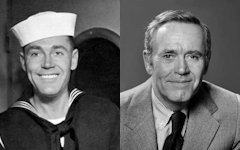 |
 |
Henry Fonda US Navy Lieutenant JG 1942-1946 |
 Henry Fonda enlisted in the United States Navy to
fight in World War II, saying, "I don't want to be in a fake war in a studio." He served for a year, initially as a Quartermaster 3rd Class on the destroyer USS
Satterlee (DD-626). Recommending Fonda for a promotion in 1945, Vice Adm. J.H. Hoofer reported that Fonda was, "Intelligent, determined, zealous, loyal and
thoroughly cooperative in all and every respect." All in all, he said, "An outstanding officer." He was commissioned as a Lieutenant Junior Grade in Air Combat
Intelligence in the Central Pacific. Henry Fonda enlisted in the United States Navy to
fight in World War II, saying, "I don't want to be in a fake war in a studio." He served for a year, initially as a Quartermaster 3rd Class on the destroyer USS
Satterlee (DD-626). Recommending Fonda for a promotion in 1945, Vice Adm. J.H. Hoofer reported that Fonda was, "Intelligent, determined, zealous, loyal and
thoroughly cooperative in all and every respect." All in all, he said, "An outstanding officer." He was commissioned as a Lieutenant Junior Grade in Air Combat
Intelligence in the Central Pacific.He was awarded the Bronze Star, Navy Presidential Unit Citation, American Campaign Medal, Asiatic–Pacific Campaign Medal with 2 Bronze Battle Stars, World War II Victory Medal, and the Philippine Liberation Medal with 1 Bronze Battle Star. |
|||||||||||||
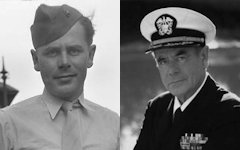 |
 |
Glen Ford USMC Captain 1941-1978 |
 Joined the Coast Guard in 1941. Joined
the USMC Reserves in 1942 as a photographic specialist at the rank of Sergeant. Went on active duty in 1943. During his service he helped build safe houses in
France for those hiding from the Nazis. He was honorably discharged in 1944 for medical reasons. He would go on to join the Navy, serve in Vietnam and retire
as a Captain. Joined the Coast Guard in 1941. Joined
the USMC Reserves in 1942 as a photographic specialist at the rank of Sergeant. Went on active duty in 1943. During his service he helped build safe houses in
France for those hiding from the Nazis. He was honorably discharged in 1944 for medical reasons. He would go on to join the Navy, serve in Vietnam and retire
as a Captain.He was awarded the Navy and Marine Corps Commendation Medal, Combat Action Ribbon, Selected Marine Corps Reserve Medal, American Defense Service Medal, American Campaign Medal, Asiatic-Pacific Campaign Medal with 1 Bronze Battle Star, World War II Victory Medal, National Defense Service Medal, Vietnam Service Medal with 3 Bronze Battle Stars, Naval Reserve Medal, Armed Forces Reserve Medal with Silver Hourglass device (20 years), Vietnamese Military Merit Medal, Commandeur of the Legion of Honour, French Liberation Medal, Vietnam Gallantry Cross Unit Citation, Republic of Vietnam Campaign Medal, and the Navy Distinguished Marksman Ribbon. |
|||||||||||||
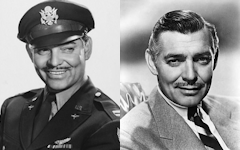 |
 |
Clark Gable US Army Air Forces Major 1942-1947 |
 In 1942, following Lombard's death,
Gable joined the U.S. Army Air Forces. Before her death, Lombard had suggested Gable enlist as part of the war effort, but MGM was obviously reluctant to let him
go, and until her death he resisted the suggestion. Gable made a public statement after Lombard's death that prompted Commanding General of the AAF Henry H.
Arnold to offer Gable a "special assignment" in aerial gunnery. Gable, despite earlier expressing an interest in officer candidate school (OCS), enlisted on
August 12, 1942, with the intention of becoming an enlisted gunner on an air crew. MGM arranged for his studio friend, cinematographer Andrew McIntyre, to
enlist with and accompany him through training. In 1942, following Lombard's death,
Gable joined the U.S. Army Air Forces. Before her death, Lombard had suggested Gable enlist as part of the war effort, but MGM was obviously reluctant to let him
go, and until her death he resisted the suggestion. Gable made a public statement after Lombard's death that prompted Commanding General of the AAF Henry H.
Arnold to offer Gable a "special assignment" in aerial gunnery. Gable, despite earlier expressing an interest in officer candidate school (OCS), enlisted on
August 12, 1942, with the intention of becoming an enlisted gunner on an air crew. MGM arranged for his studio friend, cinematographer Andrew McIntyre, to
enlist with and accompany him through training.However shortly after his enlistment he and McIntyre were sent to Miami Beach, Florida, where they entered USAAF OCS Class 42-E on August 17, 1942. Both completed training on October 28, 1942, commissioned as second lieutenants. His class of 2,600 fellow students selected Gable as their graduation speaker, at which General Arnold presented them their commissions. Arnold then informed Gable of his special assignment, to make a recruiting film in combat with the Eighth Air Force to recruit gunners. Gable and McIntyre were immediately sent to Flexible Gunnery School at Tyndall Field, Florida, followed by a photography course at Fort George Wright, Washington, and promoted to first lieutenants upon completion. Gable reported to Biggs Air Force Base on January 27, 1943, to train with and accompany the 351st Bomb Group to England as head of a six-man motion picture unit. In addition to McIntyre, he recruited screenwriter John Lee Mahin; camera operators Sgt. Mario Toti, Sgt. Robert Boles, and sound man Lt. Howard Voss to complete his crew. Gable was promoted to captain while with the 351st at Pueblo Army Air Base, Colorado, for rank commensurate with his position as a unit commander. Gable spent most of the war in the United Kingdom at RAF Polebrook with the 351st. Gable flew five combat missions, including one to Germany, as an observer-gunner in B-17 Flying Fortresses between May 4 and September 23, 1943, earning the Air Medal and the Distinguished Flying Cross for his efforts. During one of the missions, Gable's aircraft was damaged by flak and attacked by interceptors which knocked out one of the engines and shot up the stabilizer. In the raid on Germany, in which one crewman was killed and two others wounded, flak went through Gable's boot and narrowly missed his head. When word of this reached MGM, studio executives began to badger the Army Air Forces to reassign their valuable screen property to non-combat duty. In November 1943, he returned to the United States to edit the film, only to find that the personnel shortage of aerial gunners had already been rectified. He was allowed to complete the film anyway, joining the 1st Motion Picture Unit in Hollywood. In May 1944, Gable was promoted to Major. He hoped for another combat assignment but when D-Day came and passed in June without further orders, he requested and was granted a discharge. He completed editing of the film, Combat America, in September 1944, providing the narration himself and making use of numerous interviews with enlisted gunners as focus of the film. Adolf Hitler esteemed Gable above all other actors; during the Second World War he offered a sizable reward to anyone who could capture and bring Gable unscathed to him. He was awarded the Distinguished Flying Cross, Air Medal, American Campaign Medal, European-African-Middle Eastern Campaign Medal with 1 Bronze Battle Star, World War II Victory Medal, Observer Badge, and the Aerial Gunner Badge. |
|||||||||||||
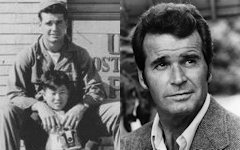 |
 |
James Garner US Army Corporal 1944-1945 1949-1952 |
 Born James Scott Bumgarner, Garner
joined the Merchant Marine at the age of 16 but left a year later due to chronic sea sickness. He would later join the Army and serve in Korea in the 24th Infantry
Division. Wounded first by shrapnel in the face and hand and a second time in the buttocks by a US fighter jet as he dove into a foxhole. Born James Scott Bumgarner, Garner
joined the Merchant Marine at the age of 16 but left a year later due to chronic sea sickness. He would later join the Army and serve in Korea in the 24th Infantry
Division. Wounded first by shrapnel in the face and hand and a second time in the buttocks by a US fighter jet as he dove into a foxhole.He was awarded the Purple Heart with 1 Bronze Oak Leaf Cluster, Army Presidential Unit Citation, National Defense Service Medal, Korea Service Medal with 4 Bronze Battle Stars, Merchant Marine Combat Ribbon, Merchant Marine World War II Victory Medal, United Nations Service Medal Korea, and the Korean Presidential Unit Citation. |
|||||||||||||
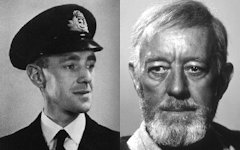 |
 |
Sir Alec Guiness British Royal Navy Lieutenant 1941-1943 |
He was awarded the 1939–45 Star, Italy Star, and the War Medal 1939-1945. |
|||||||||||||
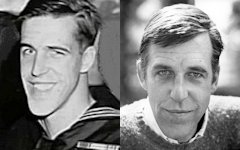 |
 |
Fred Gwynne US Navy Radioman Petty Officer Third Class 1944-1948 |
 Gwynne joined the Navy as a Radioman and
served aboard the USS Manville (PC-581) in the South Pacific. He saw action at the Battle of Saipan and the Battle of Tinian. Gwynne joined the Navy as a Radioman and
served aboard the USS Manville (PC-581) in the South Pacific. He saw action at the Battle of Saipan and the Battle of Tinian.He was awarded the Combat Action Ribbon, Navy Good Conduct Medal, American Campaign Medal, Asiatic-Pacific Campaign Medal with 1 Bronze Battle Star, and the World War II Victory Medal. |
|||||||||||||
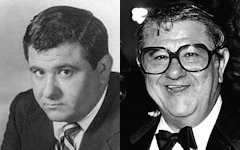 |
 |
Buddy Hackett US Army Private First Class 1942-1945 |
 Served on an anti-aircraft battery. Served on an anti-aircraft battery.He was awarded the Army Good Conduct Medal, American Campaign Medal, World War II Victory Medal, and the Honorable Discharge Pin. |
|||||||||||||
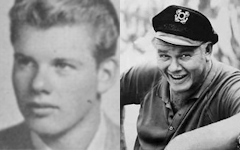 |
 |
Alan Hale, Jr. US Coast Guard Seaman First Class 1942-1945 |
 Assigned to the Command Center, Coast
Guard Headquarters, Washington, DC. Assigned to the Command Center, Coast
Guard Headquarters, Washington, DC.He was awarded the American Campaign Medal, and the World War II Victory Medal. Alan Hale, Jr. was buried at sea in the Pacific Ocean. |
|||||||||||||
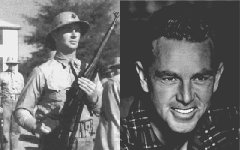 |
 |
Sterling Hayden USMC Captain 1942-1945 |
 Born Sterling Walter, Hayden
enlisted in the Army and was sent to Scotland but was discharged when he broke his ankle during training. He returned to the US and enlisted in the USMC under
the name John Hamilton. He attended OCS and was commissioned as a 2nd Lieutenant. He then served in the OSS as an undercover agent in Croatia and Italy. He
sailed supplies from Italy to Yugoslav partisans through enemy waters and parachuted into fascist Croatia. He also participated in the Naples–Foggia campaign
and established air crew rescue teams in enemy-occupied territory. Born Sterling Walter, Hayden
enlisted in the Army and was sent to Scotland but was discharged when he broke his ankle during training. He returned to the US and enlisted in the USMC under
the name John Hamilton. He attended OCS and was commissioned as a 2nd Lieutenant. He then served in the OSS as an undercover agent in Croatia and Italy. He
sailed supplies from Italy to Yugoslav partisans through enemy waters and parachuted into fascist Croatia. He also participated in the Naples–Foggia campaign
and established air crew rescue teams in enemy-occupied territory.He was awarded the Silver Star, Combat Action Ribbon, American Campaign Medal, European-African-Middle Eastern Campaign Medal with 2 Bronze Battle Stars, and the World War II Victory Medal. Sterling Hayden was buried at sea. |
|||||||||||||
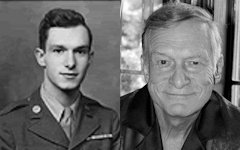 |
 |
Hugh Hefner US Army Private First Class 1944-1946 |
 Hefner served as a writer for a military
newspaper. Hefner served as a writer for a military
newspaper.He was awarded the Army Good Conduct Medal, American Campaign Medal, World War II Victory Medal, and the Honorable Discharge Pin. |
|||||||||||||
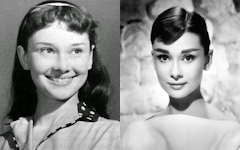 |
Audrey Hepburn Dutch Resistance Courier |
|||||||||||||||
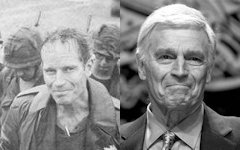 |
 |
Charlton Heston US Army Air Forces Staff Sergeant 1944-1946
|
 In 1944, Heston enlisted in the
United States Army Air Forces. He served for two years as a radio operator and aerial gunner aboard a B-25 Mitchell stationed in the Alaskan Aleutian Islands
with the Eleventh Air Force. In 1944, Heston enlisted in the
United States Army Air Forces. He served for two years as a radio operator and aerial gunner aboard a B-25 Mitchell stationed in the Alaskan Aleutian Islands
with the Eleventh Air Force.He was awarded the Presidential Medal of Freedom, Army Good Conduct Medal, American Campaign Medal, Asiatic-Pacific Campaign Medal with 1 Bronze Battle Star, World War II Victory Medal, and the Honorable Discharge Pin. |
|||||||||||||
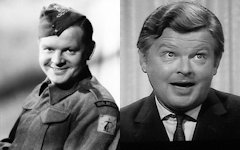 |
Benny Hill British Army Private 1942-1947 |
 In 1942, Hill was called to duty by the
British Army and was trained as a mechanic in the Royal Electrical and Mechanical Engineers. He served as a mechanic, truck driver, and searchlight
operator in Normandy and later transferred to the Combined Services Entertainment division. In 1942, Hill was called to duty by the
British Army and was trained as a mechanic in the Royal Electrical and Mechanical Engineers. He served as a mechanic, truck driver, and searchlight
operator in Normandy and later transferred to the Combined Services Entertainment division. |
||||||||||||||
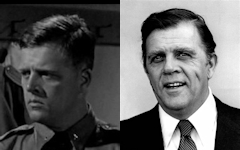 |
 |
Pat Hingle US Navy Boiler Technician Petty Officer First Class 1941-1945 |
 Hingle dropped out of the University of Texas
when World War II broke out and joined the Navy. He served as a Boiler Technician on the USS Marshall (DD-676) in the Pacific. He fought at the Naval attack of Truk
(Operation Hailstone), Marshall Islands Operation, Battle of Philippine Sea, Mariana and Palau Islands Campaign, Battle of Guam, Battle of Tinian, Battle for Ulithi
Atoll, Battle of Leyte Gulf, Luzon Campaign, Iwo Jima Operation, Okinawa Gunto Operation, and East of Kyushu. Hingle dropped out of the University of Texas
when World War II broke out and joined the Navy. He served as a Boiler Technician on the USS Marshall (DD-676) in the Pacific. He fought at the Naval attack of Truk
(Operation Hailstone), Marshall Islands Operation, Battle of Philippine Sea, Mariana and Palau Islands Campaign, Battle of Guam, Battle of Tinian, Battle for Ulithi
Atoll, Battle of Leyte Gulf, Luzon Campaign, Iwo Jima Operation, Okinawa Gunto Operation, and East of Kyushu.He was awarded the Combat Action Ribbon, American Campaign Medal, Asiatic-Pacific Campaign Medal with 2 Silver Battle Stars (each counts as 5 Bronze Battle Stars) and 1 Bronze Battle Star, World War II Victory Medal, and the Philippine Liberation Medal. |
|||||||||||||
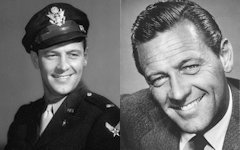 |
 |
William Holden US Army Air Forces First Lieutenant 1942-1945 |
 Served in the First Motion Picture Unit
where he acted in training films. Served in the First Motion Picture Unit
where he acted in training films.He was awarded the American Campaign Medal, and the World War II Victory Medal. |
|||||||||||||
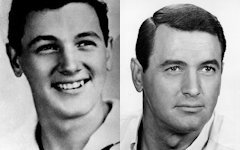 |
 |
Rock Hudson US Navy Aviation Machinist's Mate Airman First Class 1943-1946 |
 Born Raymond Harold Scherer Jr, Rock
Hudson served as an aircraft mechanic at the Aviation Repair and Overhaul Unit 2, NAS Samar, Philippines. Born Raymond Harold Scherer Jr, Rock
Hudson served as an aircraft mechanic at the Aviation Repair and Overhaul Unit 2, NAS Samar, Philippines.He was awarded the American Campaign Medal, Asiatic-Pacific Campaign Medal, and the World War II Victory Medal. Rock Hudson was buried at sea. |
|||||||||||||
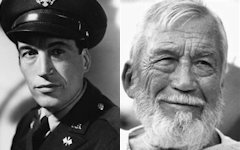 |
 |
John Huston US Army First Lieutenant 1942-1946 |
 Huston served as a First Lieutenant in the
Signal Corps and went on to lead a number of film documentaries for the U.S. government including the controversial Let There Be Light (1946), which his father Walter
narrated. Huston served as a First Lieutenant in the
Signal Corps and went on to lead a number of film documentaries for the U.S. government including the controversial Let There Be Light (1946), which his father Walter
narrated.He was awarded the American Campaign Medal, Asiatic-Pacific Campaign Medal with 1 Bronze Battle Star, and the World War II Victory Medal. |
|||||||||||||
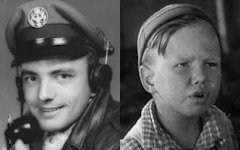 |
 |
Bobby Hutchins US Army Air Forces Student Pilot 1943-1945 |
 Known as "Wheezer" from Our Gang, Hutchins
was killed in a plane crash a week before graduating pilot training. Known as "Wheezer" from Our Gang, Hutchins
was killed in a plane crash a week before graduating pilot training. |
|||||||||||||
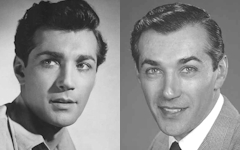 |
 |
Rick Jason US Army Air Forces Corporal 1943-1945 |
 Served at the Air Force
Bases/Installations, Plattsburg Convalescent Hospital. Served at the Air Force
Bases/Installations, Plattsburg Convalescent Hospital.He was awarded the American Campaign Medal, and the World War II Victory Medal. |
|||||||||||||
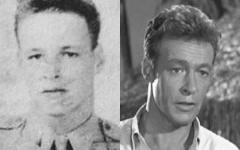 |
 |
Russell Johnson US Army Air Forces First Lieutenant 1942-1957 |
 Enlisted in the U.S. Army in
November 1942 to become an aviation cadet. He was then discharged in January 1944 to accept a commission as an officer at the rank of Second Lieutenant. He flew
44 combat missions as a bombardier in a B-25 Mitchell bomber. In March 1945, during a bombing run against Japanese targets, his plane was shot down. In the crash,
he broke both of his ankles and his co-pilot was killed. After making the rank of First Lieutenant, he was discharged on November 22, 1945. He then joined the Army
reserves before being transferred to the Air Force reserves where he served until August 1957. Enlisted in the U.S. Army in
November 1942 to become an aviation cadet. He was then discharged in January 1944 to accept a commission as an officer at the rank of Second Lieutenant. He flew
44 combat missions as a bombardier in a B-25 Mitchell bomber. In March 1945, during a bombing run against Japanese targets, his plane was shot down. In the crash,
he broke both of his ankles and his co-pilot was killed. After making the rank of First Lieutenant, he was discharged on November 22, 1945. He then joined the Army
reserves before being transferred to the Air Force reserves where he served until August 1957.He was awarded the Bronze Star, Purple Heart, Air Medal with 1 Bronze Oak Leaf, Army Good Conduct Medal, American Campaign Medal, Asiatic-Pacific Campaign Medal with 3 Bronze Battle Stars, World War II Victory Medal, National Defense Service Medal, Armed Forces Reserve Medal, Philippine Liberation Medal, Bombardier Badge, Honorable Discharge Pin. |
|||||||||||||
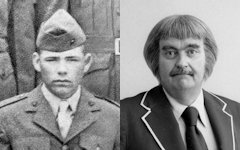 |
 |
Bob Keeshan USMC Private First Class 1945-1946 |
 Robert Keeshan enlisted late in
1945 and by the time his basic training was finished, the war would be over within 2 weeks. He was with the 2nd Marine Division at Camp Lejeune until 1946 and
then spent the next year aboard the USS Thomas Jefferson (APA-30). Robert Keeshan enlisted late in
1945 and by the time his basic training was finished, the war would be over within 2 weeks. He was with the 2nd Marine Division at Camp Lejeune until 1946 and
then spent the next year aboard the USS Thomas Jefferson (APA-30).He was awarded the Combat Action Ribbon, Navy Presidential Unit Citation, China Service Medal, American Campaign Medal, Asiatic-Pacific Campaign Medal, World War II Victory Medal, and the Navy Occupation Medal. |
|||||||||||||
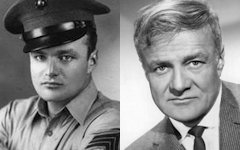 |
 |
Brian Keith USMC Sergeant 1941-1945 |
 Brian Keith was a Radio-Gunner in the rear
cockpit of a two-man Douglass Dauntless (SDB) dive-bomber in a USMC squadron, VMSB-243. During an attack on Rabaul, his plane was badly damaged by enemy ground fire. The
pilot struggled to keep the plane in the air. Unable to keep up with the others, it fell behind. Two Japanese Zero fighters attacked the crippled plane from the
rear. Both of Keith's machine guns jammed. He fired red tracer ammunition from his pistol. The Japs broke off the attack, but soon came again. Now completely
out of ammunition, Brian reached for the Very pistol and fired a red rocket/flare at the fighters which immediately pulled up to figure out what that was. On
the radio, Keith heard a New Zealand pilot saying, "Don't sweat it, Yank, I've got them surrounded up here!" Brian Keith was a Radio-Gunner in the rear
cockpit of a two-man Douglass Dauntless (SDB) dive-bomber in a USMC squadron, VMSB-243. During an attack on Rabaul, his plane was badly damaged by enemy ground fire. The
pilot struggled to keep the plane in the air. Unable to keep up with the others, it fell behind. Two Japanese Zero fighters attacked the crippled plane from the
rear. Both of Keith's machine guns jammed. He fired red tracer ammunition from his pistol. The Japs broke off the attack, but soon came again. Now completely
out of ammunition, Brian reached for the Very pistol and fired a red rocket/flare at the fighters which immediately pulled up to figure out what that was. On
the radio, Keith heard a New Zealand pilot saying, "Don't sweat it, Yank, I've got them surrounded up here!"He was awarded the Air Medal with 1 Bronze device, Combat Action Ribbon, Marine Corps Good Conduct Medal, American Campaign Medal, Asiatic-Pacific Campaign Medal with 1 Bronze Battle Star, World War II Victory Medal, Combat Air Crew Badge with 3 Bronze Stars, USMC Rifle Expert Badge, and the USMC Pistol Expert Badge. |
|||||||||||||
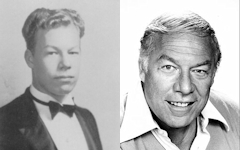 |
 |
George Kennedy US Army Captain 1943-1959 |
 Joined the Army and was assigned to Infantry where
he served under General Patton at the Battle of the Bulge. He was instrumental in establishing the Army Information Office, which provided technical service to the
film and television industries, and spun records as a disk jockey on Armed Forces Radio. A back injury ended his military career. Joined the Army and was assigned to Infantry where
he served under General Patton at the Battle of the Bulge. He was instrumental in establishing the Army Information Office, which provided technical service to the
film and television industries, and spun records as a disk jockey on Armed Forces Radio. A back injury ended his military career.He was awarded the American Campaign Medal, European-African-Middle Eastern Campaign Medal with 1 Bronze Battle Star, World War II Victory Medal, Army of Occupation Medal, and the National Defense Service Medal. |
|||||||||||||
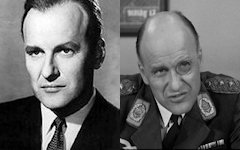 |
 |
Werner Klemperer US Army Technician Fifth Grade 1942-1945 |
 Stationed in Hawaii with the Special Services
Unit, he spent two years touring the Pacific entertaining the troops. Stationed in Hawaii with the Special Services
Unit, he spent two years touring the Pacific entertaining the troops.He was awarded the Army Good Conduct Medal, American Campaign Medal, Asiatic-Pacific Campaign Medal, World War II Victory Medal, and the Honorable Discharge Pin. Werner Klemperer was buried at sea. |
|||||||||||||
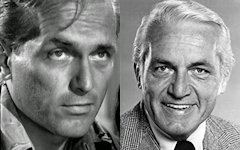 |
Ted Knight US Army Private 1941-1945 |
 Dropped out of high school to enlist in the
Army. He served with A Company, 296th Combat Engineer Battalion, as a radio reconnaissance operator. In 1945, he was with the first American troops which
entered Berlin. Dropped out of high school to enlist in the
Army. He served with A Company, 296th Combat Engineer Battalion, as a radio reconnaissance operator. In 1945, he was with the first American troops which
entered Berlin.He was awarded the American Campaign Medal, European-African-Middle Eastern Campaign Medal with 4 Bronze Battle Stars, and the World War II Victory Medal. |
||||||||||||||
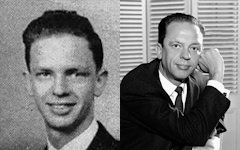 |
 |
Don Knotts US Army Technician Fifth Grade 1943-1946 |
 Toured the Pacific Islands as a comedian as part
of a GI variety show called Stars and Gripes. Toured the Pacific Islands as a comedian as part
of a GI variety show called Stars and Gripes.He was awarded the Army Good Conduct Medal, American Campaign Medal, World War II Victory Medal, and the Honorable Discharge Pin. |
|||||||||||||
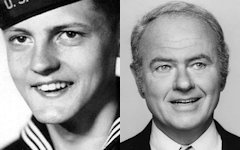 |
 |
Harvey Korman US Navy Seaman First Class 1945-1946 |
 After graduating high school, he served in the US
Naval Reserve. After graduating high school, he served in the US
Naval Reserve.He was awarded the American Campaign Medal, World War II Victory Medal, and the Honorable Discharge Pin. |
|||||||||||||
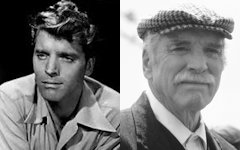 |
Burt Lancaster US Army Private 1942-1945 |
 Joined the Army after the attack at Pearl
Harbor. He served in the Special Services Unit entertaining the troops. Joined the Army after the attack at Pearl
Harbor. He served in the Special Services Unit entertaining the troops.He was awarded the Army Good Conduct Medal, American Campaign Medal, European-African-Middle Eastern Campaign Medal, World War II Victory Medal, and the Honorable Discharge Pin. |
||||||||||||||
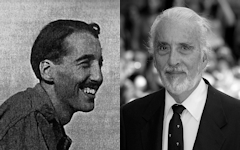 |
 |
Christopher Lee Royal Air Force Flight Lieutenant 1939-1946 |
 In 1939, Lee enrolled in a military
academy and volunteered to fight for the Finnish Army against the Soviet Union during the Winter War. He and other British volunteers were kept away from the actual
fighting, but they were issued winter gear and were posted on guard duty a safe distance from the border. After two weeks in Finland, they returned home. When
his father died in 1941, he decided to join the Royal Air Force. He was training to be a pilot but was diagnosed with optic nerve problems in his eye. He then applied
to join RAF Intelligence and was transferred to the British South Africa Police as a warden of the Salisbury Prison. Later he was transferred to the Suez Canal Zone
and was commissioned as a Pilot Officer in 1943 and served as an Intelligence Officer where he flew 5 bombing missions a day. After advancing through Northern Africa,
Lee was promoted to Flying Officer. He was promoted to Flight Lieutenant in 1944 and served at Air Force HQ where he took part in forward planning and liaison, in
preparation for a potential assault into the rumored German Alpine Fortress. In 1939, Lee enrolled in a military
academy and volunteered to fight for the Finnish Army against the Soviet Union during the Winter War. He and other British volunteers were kept away from the actual
fighting, but they were issued winter gear and were posted on guard duty a safe distance from the border. After two weeks in Finland, they returned home. When
his father died in 1941, he decided to join the Royal Air Force. He was training to be a pilot but was diagnosed with optic nerve problems in his eye. He then applied
to join RAF Intelligence and was transferred to the British South Africa Police as a warden of the Salisbury Prison. Later he was transferred to the Suez Canal Zone
and was commissioned as a Pilot Officer in 1943 and served as an Intelligence Officer where he flew 5 bombing missions a day. After advancing through Northern Africa,
Lee was promoted to Flying Officer. He was promoted to Flight Lieutenant in 1944 and served at Air Force HQ where he took part in forward planning and liaison, in
preparation for a potential assault into the rumored German Alpine Fortress.After the war, he was asked to join the Central Registry of War Criminals and Security Suspects. This group was tasked with finding Nazi war criminals. Lee said: "We were given dossiers of what they'd done and told to find them, interrogate them as much as we could and hand them over to the appropriate authority". He was awarded the 1939–45 Star, Italy Star, and the War Medal 1939-1945. |
|||||||||||||
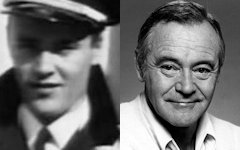 |
 |
Jack Lemmon US Navy Ensign 1943-1946 |
 Enrolled at Harvard University in 1943 where
he also joined the Naval Reserves. He was then sent to the V-12 Navy College Training Program. After training, he was stationed aboard the aircraft carrier USS Lake
Champlain (CV-39). Enrolled at Harvard University in 1943 where
he also joined the Naval Reserves. He was then sent to the V-12 Navy College Training Program. After training, he was stationed aboard the aircraft carrier USS Lake
Champlain (CV-39).He was awarded the American Campaign Medal, and the World War II Victory Medal. |
|||||||||||||
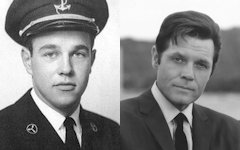 |
 |
Jack Lord US Merchant Marine Lieutenant 1942-1948 |
 Born John Joseph Patrick Ryan,
Lord joined the Merchant Marines as an Able Seaman before enrolling in the deck officer course at the United States Merchant Marine Academy. He graduated
as an Ensign with a Third Mates License and served aboard Liberty ships during the war. One of the ships he was serving on was torpedoed, and he barely
escaped with his life. By war’s end, Jack was a Mate Navigator. At the end of World War II, Lord returned went to Iran for fourteen months to
work with the Corps of Engineers, then a part of the War Department. He was a steel worker and helped to build roads and bridges. Upon returning Stateside,
he was sent to Washington, DC, for two years. There, he served as an artist for a service magazine and made training films for the U.S. Maritime
Service. Born John Joseph Patrick Ryan,
Lord joined the Merchant Marines as an Able Seaman before enrolling in the deck officer course at the United States Merchant Marine Academy. He graduated
as an Ensign with a Third Mates License and served aboard Liberty ships during the war. One of the ships he was serving on was torpedoed, and he barely
escaped with his life. By war’s end, Jack was a Mate Navigator. At the end of World War II, Lord returned went to Iran for fourteen months to
work with the Corps of Engineers, then a part of the War Department. He was a steel worker and helped to build roads and bridges. Upon returning Stateside,
he was sent to Washington, DC, for two years. There, he served as an artist for a service magazine and made training films for the U.S. Maritime
Service.He was awarded the Navy Presidential Unit Citation, Merchant Marine Atlantic War Zone Medal, Merchant Marine Mediterranean-Middle East War Zone Medal, Merchant Marine World War II Victory Medal, Merchant Marine Expeditionary Medal, Naval Reserve Badge, and the Honorable Discharge Pin. Jack Lord was buried at sea in the Pacific Ocean. |
|||||||||||||
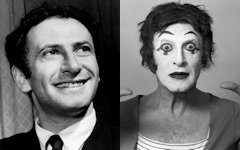 |
Marcel Marceau French Resistance |
 Marceau was born in France to a
Jewish family. When he was 5 years old, his mother took him to see a Charlie Chaplin movie. He was so thrilled by the performance that it led him to want
to become a mime. When he was just 17 years old, Nazi Germany invaded. His cousin encouraged him to join the French Jewish Resistance in the rescue of
Jews during the Holocaust. They rescued thousands of children and adults throughout France. In order to keep the kids quiet, he used mime to communicate
while helping them escape to Switzerland. Marceau attended school by pretending to be a worker at the school. In 1944, his father was captured by the
Gestapo and sent to the Auschwitz concentration camp and was killed. After the liberation of Paris, he joined the French Army as a liaison officer with
General Patton's Third Army. Marceau was born in France to a
Jewish family. When he was 5 years old, his mother took him to see a Charlie Chaplin movie. He was so thrilled by the performance that it led him to want
to become a mime. When he was just 17 years old, Nazi Germany invaded. His cousin encouraged him to join the French Jewish Resistance in the rescue of
Jews during the Holocaust. They rescued thousands of children and adults throughout France. In order to keep the kids quiet, he used mime to communicate
while helping them escape to Switzerland. Marceau attended school by pretending to be a worker at the school. In 1944, his father was captured by the
Gestapo and sent to the Auschwitz concentration camp and was killed. After the liberation of Paris, he joined the French Army as a liaison officer with
General Patton's Third Army. |
||||||||||||||
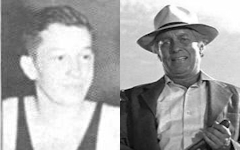 |
 |
Strother Martin US Navy Specialist (Athletics Instructor) Petty Officer Third Class 1942-1946 |
 Martin grew up in Indiana where he excelled at
swimming and diving. At the age of 17, he won the National Junior Springboard Diving Championship. He joined the Navy and served as a swimming instructor at Recruit
Training Center, San Diego. Martin grew up in Indiana where he excelled at
swimming and diving. At the age of 17, he won the National Junior Springboard Diving Championship. He joined the Navy and served as a swimming instructor at Recruit
Training Center, San Diego.He was awarded the American Campaign Medal, and the World War II Victory Medal. |
|||||||||||||
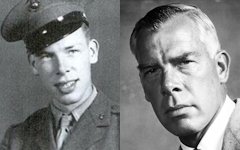 |
 |
Lee Marvin USMC Private First Class 1942-1945 |
 Served as a Scout-Sniper in I Company,
3rd Battalion, 24th Marines, 4th Marine Division. He served at the Battle of Roi-Namur Island and was shot twice in the Battle of Saipan. Served as a Scout-Sniper in I Company,
3rd Battalion, 24th Marines, 4th Marine Division. He served at the Battle of Roi-Namur Island and was shot twice in the Battle of Saipan.He was awarded the Purple Heart, Navy Commendation Medal with Bronze V device, Combat Action Ribbon, Presidential Unit Citation, American Campaign Medal, Asiatic-Pacific Campaign Medal with 1 Bronze Battle Star, World War II Victory Medal, Rifle Expert Badge, USMC Basic Qualification Badge, and the Honorable Discharge Pin. Lee Marvin is buried at Arlington National Cemetery. |
|||||||||||||
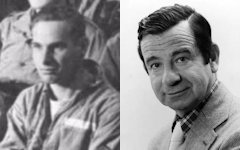 |
 |
Walter Matthau US Army Air Forces Staff Sergeant 1942-1945 |
 Enlisted in the Army Air Forces
as a B-24 Liberator radioman-gunner assigned to the Eighth Air Force, 453rd Bombardment Group, Heavy, stationed at RAF Old Buckenham, near Attleborough, Norfolk,
England, USAAF Air Station 144. The group began bombing in February 1944 and participated in the concentrated attack against the German aircraft industry during Big
Week, 20–25 February 1944. They bombed V-weapon sites, airfields, and gun batteries in France prior to the invasion of Normandy in June 1944 and on 6 June, they hit
shore installations between Le Havre and Cherbourg and other enemy positions farther inland. They also bombed German communications during the Battle of the Bulge,
Dec 1944-Jan 1945. Enlisted in the Army Air Forces
as a B-24 Liberator radioman-gunner assigned to the Eighth Air Force, 453rd Bombardment Group, Heavy, stationed at RAF Old Buckenham, near Attleborough, Norfolk,
England, USAAF Air Station 144. The group began bombing in February 1944 and participated in the concentrated attack against the German aircraft industry during Big
Week, 20–25 February 1944. They bombed V-weapon sites, airfields, and gun batteries in France prior to the invasion of Normandy in June 1944 and on 6 June, they hit
shore installations between Le Havre and Cherbourg and other enemy positions farther inland. They also bombed German communications during the Battle of the Bulge,
Dec 1944-Jan 1945.He was awarded the Air Medal, Army Good Conduct Medal, American Campaign Medal, European-African-Middle Eastern Campaign Medal with 1 Silver Battle Star, World War II Victory Medal, Aerial Gunner Badge, Expert Marksman with Aeroweapons Badge, Sharpshooter Marksman with Pistol Badge, and the Honorable Discharge Pin. |
|||||||||||||
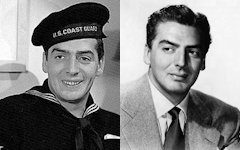 |
 |
Victor Mature US Coast Guard Boatswain's Mate Chief Petty Officer 1942-1945 |
 Rejected by the Navy for color
blindness, he took a different test the same day for the Coast Guard and passed. He was assigned to the USCGC Storis (WMEC-38), an ice breaker from Boston that
patrolled the Greenland area. In 1944 he did a series of War Bond tours and acted in morale shows. He assisted Coast Guard recruiting efforts by being a featured
player in the musical revue "Tars and Spars" which opened in Miami, FL in April 1944 and toured the United States for the next year. On 15 May 1945 Mature was
reassigned to the Coast Guard manned troop transport USS Admiral H. T. Mayo (AP-125) which was involved in transferring troops to the Pacific Theater. Rejected by the Navy for color
blindness, he took a different test the same day for the Coast Guard and passed. He was assigned to the USCGC Storis (WMEC-38), an ice breaker from Boston that
patrolled the Greenland area. In 1944 he did a series of War Bond tours and acted in morale shows. He assisted Coast Guard recruiting efforts by being a featured
player in the musical revue "Tars and Spars" which opened in Miami, FL in April 1944 and toured the United States for the next year. On 15 May 1945 Mature was
reassigned to the Coast Guard manned troop transport USS Admiral H. T. Mayo (AP-125) which was involved in transferring troops to the Pacific Theater.He was awarded the American Campaign Medal, European-African-Middle Eastern Campaign Medal, Asiatic-Pacific Campaign Medal, World War II Victory Medal, and the Honorable Discharge Pin. |
|||||||||||||
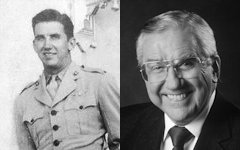 |
 |
Ed McMahon USMC Colonel 1943-1966 |
 McMahon hoped to become a US
Marine Corps fighter pilot. Prior to the US entry into World War II, both the Army and Navy required two years of college for their pilots program. McMahon enrolled
into classes at Boston College. After Pearl Harbor was attacked, the college requirement was dropped, and McMahon immediately applied for Marine flight training.
His primary flight training was in Dallas, followed by fighter training in Pensacola, where he also earned his carrier landing qualifications. He was a Marine Corps
flight instructor for two years, finally being ordered to the Pacific fleet in 1945. However, his orders were canceled after the atomic bomb was dropped on
Hiroshima and Nagasaki forcing Japan's surrender. McMahon hoped to become a US
Marine Corps fighter pilot. Prior to the US entry into World War II, both the Army and Navy required two years of college for their pilots program. McMahon enrolled
into classes at Boston College. After Pearl Harbor was attacked, the college requirement was dropped, and McMahon immediately applied for Marine flight training.
His primary flight training was in Dallas, followed by fighter training in Pensacola, where he also earned his carrier landing qualifications. He was a Marine Corps
flight instructor for two years, finally being ordered to the Pacific fleet in 1945. However, his orders were canceled after the atomic bomb was dropped on
Hiroshima and Nagasaki forcing Japan's surrender.As an officer in the reserves, McMahon was recalled to active duty during the Korean War. This time, he flew the OE-1 (the original Marine designation for the Cessna O-1 Bird Dog), an unarmed single-engine spotter plane. He functioned as an artillery spotter for the Marine batteries on the ground and as a forward controller for the Navy and Marine fighter bombers. He flew a total of 85 combat missions, earning 6 Air Medals. After the war, he stayed with the Marines, as a reserve officer, retiring in 1966 as a Colonel. He was later commissioned to the rank of Brigadier General in the California National Guard. He was awarded the Air Medal with Bronze 6 device, American Campaign Medal, World War II Victory Medal, National Defense Service Medal with 1 Bronze Star, Korea Service Medal, Marine Corps Reserve Ribbon, United Nations Service Medal (Korea), Republic of Korea War Service Medal, and Naval Aviator Pilot Wings. |
|||||||||||||
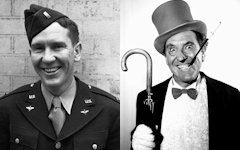 |
 |
Burgess Meredith US Army Air Forces Captain 1942-1945 |
 Meredith enlisted on 27 Feb 1942. He
transferred to the Office of War Information and was involved in making films for GIs. During his service, in 1943, Meredith starred in the military short film,
Rear Gunner. A rousing recruitment film for the Army Air Corps where a young rural enlistee is initially disappointed with his job as an air mechanic, but his
great marksmanship skills make him an ideal tail gunner. He was discharged in 1945 to work on the movie The Story of G.I. Joe, in which he starred as the popular
war correspondent Ernie Pyle. Meredith enlisted on 27 Feb 1942. He
transferred to the Office of War Information and was involved in making films for GIs. During his service, in 1943, Meredith starred in the military short film,
Rear Gunner. A rousing recruitment film for the Army Air Corps where a young rural enlistee is initially disappointed with his job as an air mechanic, but his
great marksmanship skills make him an ideal tail gunner. He was discharged in 1945 to work on the movie The Story of G.I. Joe, in which he starred as the popular
war correspondent Ernie Pyle.He was awarded the American Campaign Medal, and the World War II Victory Medal. |
|||||||||||||
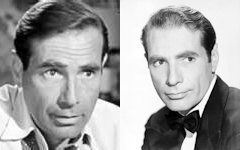 |
 |
Gary Merrill US Army Air Forces Corporal 1941-1944 |
 Merrill served in the
Special Services Unit. Merrill served in the
Special Services Unit.He was awarded the American Defense Service Medal, American Campaign Medal, World War II Victory Medal, and the Honorable Discharge Pin. |
|||||||||||||
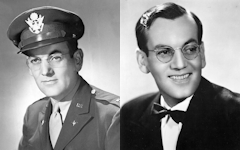 |
 |
Glenn Miller US Army Air Forces Major 1942-1944 |
 In 1942, at the peak of his
civilian career, Miller decided to join the war effort. At 38, Miller was too old to be drafted, and first volunteered for the Navy but was told that they did not
need his services. Miller then wrote to Army Brigadier General Charles Young. He persuaded the United States Army to accept him so he could, in his own words, "be
placed in charge of a modernized Army band." In 1942, at the peak of his
civilian career, Miller decided to join the war effort. At 38, Miller was too old to be drafted, and first volunteered for the Navy but was told that they did not
need his services. Miller then wrote to Army Brigadier General Charles Young. He persuaded the United States Army to accept him so he could, in his own words, "be
placed in charge of a modernized Army band."At first Miller was placed in the United States Army but was transferred to the Army Air Force. Captain Glenn Miller served initially as assistant special services officer for the Army Air Forces Southeast Training Center at Maxwell Field, Montgomery, Alabama, in December 1942. He played trombone with the Rhythmaires, a 15-piece dance band, in both Montgomery and in service clubs and recreation halls on Maxwell. Miller also appeared on both WAPI (Birmingham, Alabama) and WSFA radio (Montgomery), promoting the activities of civil service women aircraft mechanics employed at Maxwell. Miller initially formed a large marching band that was to be the core of a network of service orchestras. Miller's attempts at modernizing military music were met with some resistance from tradition-minded career officers. For example, Miller's arrangement of "St. Louis Blues March," which combined blues and jazz with the traditional military march. Miller's weekly radio broadcast "I Sustain the Wings" moved from New Haven to New York City and was very popular. This led to permission for Miller to form his 50-piece Army Air Force Band and take it to England in the summer of 1944, where he gave 800 performances. While in England, now Major Miller recorded a series of records at HMV (now EMI) owned Abbey Road Studios. HMV at this time was the British and sometime European distributor for the American record company that handled and originated Glenn Miller's recordings, RCA Victor. The recordings the AAF band made in 1944 at Abbey Road were propaganda broadcasts for the Office of War Information. Many songs are sung in German by Johnny Desmond and Glenn Miller speaks in German about the war effort. Also, the Miller-led AAF Orchestra recorded songs with the American singer Dinah Shore. These were done at the Abbey Road studios and were the last recorded songs made by the band while being led by Miller. They were stored with HMV/EMI for fifty years, never being released until their copyright expired in Europe in 1994. In summarizing Miller's military career, General Jimmy Doolittle said, "next to a letter from home, that organization was the greatest morale builder in the European Theater of Operations." On December 15, 1944, Miller was to fly from the United Kingdom to Paris, France, to play for the soldiers who had recently liberated Paris. His plane, a single-engine UC-64 Norseman, departed from RAF Twinwood Farm in Clapham, Bedfordshire and disappeared while flying over the English Channel. No trace of the aircrew, passengers or plane has ever been found. Miller's status is missing in action. He was awarded the Bronze Star Medal, American Campaign Medal, European-African-Middle Eastern Campaign Medal with 2 Bronze Battle Stars, World War II Victory Medal, and the Expert Marksman Badge with Carbine and Pistol Bars. |
|||||||||||||
 |
 |
Robert Montgomery US Navy Lieutenant Commander 1941-1946 |
 In 1940, Montgomery was anxious to
contribute to the war effort so he went to France where he volunteered to drive an ambulance for several weeks. Upon returning to the US, he decided to enlist in
the US Naval Reserves. He was sent to the Intelligence Section in the map room of the U.S. Naval Attache's office in London where he worked as an assistant. He then
returned to the U.S. where he was assigned to set up a naval operations room in the White House. From 1942-1943, he served as the XO aboard the PT Boats, PT-114, PT-68,
and PT-107 in the South Pacific. He was also with a Marine Detachment at the Guadalcanal-Tulagi landings. Later in 1943, Montgomery was stationed aboard the USS
Barton (DD-722). The Barton was among the many ships sent to Normandy on D-Day, June 6, 1944 as part of Operation Overlord. Montgomery was awarded the Bronze Star
with the Combat V device for his actions. He was then stationed aboard the USS Columbia (CL-56) until the end of the war in 1945. In 1940, Montgomery was anxious to
contribute to the war effort so he went to France where he volunteered to drive an ambulance for several weeks. Upon returning to the US, he decided to enlist in
the US Naval Reserves. He was sent to the Intelligence Section in the map room of the U.S. Naval Attache's office in London where he worked as an assistant. He then
returned to the U.S. where he was assigned to set up a naval operations room in the White House. From 1942-1943, he served as the XO aboard the PT Boats, PT-114, PT-68,
and PT-107 in the South Pacific. He was also with a Marine Detachment at the Guadalcanal-Tulagi landings. Later in 1943, Montgomery was stationed aboard the USS
Barton (DD-722). The Barton was among the many ships sent to Normandy on D-Day, June 6, 1944 as part of Operation Overlord. Montgomery was awarded the Bronze Star
with the Combat V device for his actions. He was then stationed aboard the USS Columbia (CL-56) until the end of the war in 1945.He was awarded the Bronze Star with Combat V device, Combat Action Ribbon, American Defense Service Medal, American Campaign Medal, European-African-Middle Eastern Campaign Medal with 2 Bronze Battle Stars, Asiatic-Pacific Campaign Medal with 2 Bronze Battle Stars and 1 Bronze Fleet Marine Force Combat Operation Insignia 'EGA' device, and the World War II Victory Medal. |
|||||||||||||
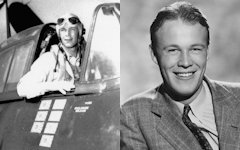 |
 |
Wayne Morris US Navy Lieutenant Commander 1941-1946 |
 As an actor in 1940, Morris was cast in
the film Flight Angels. For his role, he had to learn to fly. In 1941, he was commissioned as an Ensign in the Naval Reserves. Morris was trained as a military pilot,
and after a year as a flight instructor, he eventually went into combat in the Pacific theater as an F6F Hellcat pilot stationed on the aircraft carrier USS Essex
(CV-9). Morris' combat record included 57 missions and seven kills, qualifying him as an ace. Three of his planes were so badly damaged by enemy fire during his
combat duty that they were dumped into the seas as 'unfit for duty.' As an actor in 1940, Morris was cast in
the film Flight Angels. For his role, he had to learn to fly. In 1941, he was commissioned as an Ensign in the Naval Reserves. Morris was trained as a military pilot,
and after a year as a flight instructor, he eventually went into combat in the Pacific theater as an F6F Hellcat pilot stationed on the aircraft carrier USS Essex
(CV-9). Morris' combat record included 57 missions and seven kills, qualifying him as an ace. Three of his planes were so badly damaged by enemy fire during his
combat duty that they were dumped into the seas as 'unfit for duty.'On September 14, 1959, Morris was a guest of his former commander and was watching aerial maneuvers on an aircraft carrier when he had a heart attack and died. He was awarded the Distinguished Flying Cross with 2 Gold Stars, Air Medal with a Bronze 2 device, Combat Action Ribbon, Navy Presidential Unit Citation, China Service Medal, American Defense Service Medal, American Campaign Medal, Asiatic-Pacific Campaign Medal with 2 Silver Battle Stars (each counts as 5 Bronze Battle Stars) and 2 Bronze Battle Stars, World War II Victory Medal, Navy Occupation Service Medal, Philippine Presidential Unit Citation, Philippine Liberation Medal with 1 Bronze Battle Star, Distinguished Marksman Badge Pistol, Naval Aviator Wings Badge, and seven confirmed kills. Wayne Morris is buried at Arlington National Cemetery. |
|||||||||||||
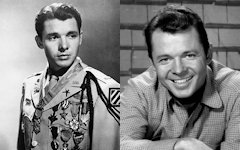 |
 |
Audie Murphy US Army Major 1942-1945
|
 Murphy always wanted to be a soldier and
after the attack at Pearl Harbor, he tried to enlist but was underage. His sister provided an affidavit stating he was of age and he was accepted into the
Army on 30 June 1942. He went to basic training at Camp Wolters and advanced infantry training at Fort Meade. During basic training, he earned the Marksman
Badge with Rifle Component Bar and Expert Badge with Bayonet Component Bar. Murphy always wanted to be a soldier and
after the attack at Pearl Harbor, he tried to enlist but was underage. His sister provided an affidavit stating he was of age and he was accepted into the
Army on 30 June 1942. He went to basic training at Camp Wolters and advanced infantry training at Fort Meade. During basic training, he earned the Marksman
Badge with Rifle Component Bar and Expert Badge with Bayonet Component Bar.On 20 February 1943, he was sent to Casablanca in French Morocco and was assigned to B Company, 15th Infantry Regiment, 3rd Infantry Division. He was a platoon messenger with his division in Algeria while training for the assault landings in Sicily. He was promoted to private first class on 7 May and then to corporal on 15 July. After landing in Sicily, he was the division runner. While on a scouting patrol, he killed two fleeing Italian Officers. In September, his scouting party was ambushed by Germans, killing one of his party. He and the other survivor killed 5 Germans with hand grenades and machinegun fire. In October, his company was attacked by 7 Germans. His company killed 3 and took 4 as prisoners. He was promoted to Sergeant on 13 December. In January 1944, he was promoted to Staff Sergeant. He was hospitalized in Naples for malaria on 21 January and missed the landing at Anzio Beach. He returned on 29 January and participated in the First Battle of Cisterna and was made platoon sergeant in B Company after that battle. While sheltering for weather on 2 March, he and his platoon killed the crew of a passing German tank. He then crawled alone to get close enough to destroy the tank with rifle grenades and was awarded the Bronze Star with "V" device. He continued to make scouting patrols to take German prisoners and was again hospitalized by malaria on 13 March. On 8 May, 61 infantry officers and enlisted men of B Company were awarded the Combat Infantryman Badge. He was also awarded the Bronze Oak Leaf Cluster for his Bronze Star. American forces liberated Rome on 4 June and Murphy remained in Rome with his platoon through July. During the first wave of the Allied invasion into southern France, Murphy received the Distinguished Service Cross for action on 15 August 1944. After landing on Yellow Beach, his platoon was attacked by Germans. With a machinegun, he killed two and injured one. When two Germans exited a farmhouse and appeared to surrender, the Germans opened fire and killed Murphy's best friend. Murphy advanced alone under direct fire and killed 6, wounded 2 and took 11 as prisoner. He was part of the First Battalion that secured an area of Germans at Montelimar and they were all awarded the Presidential Unit Citation. In September, his foot was injured from a mortar shell and he was awarded his first Purple Heart. In October, he killed 4 Germans and injured 3 at a German machinegun post and was awarded his first Silver Star. Just three days later, he crawled alone towards the Germans carrying a radio to direct his men for an hour while the Germans were firing directly at him. When his unit finally took the hill, 15 Germans were killed and 35 were wounded. He was awarded the Bronze Oak Leaf Cluster for his Silver Star and was also awarded a battlefield commission to Second Lieutenant and was now the platoon leader. In late October, his platoon was attacked by a German sniper group. Murphy captured two before being shot in the hip by a sniper. He returned fire and shot the sniper between the eyes. He was awarded a Bronze Oak Leaf Cluster for his Purple Heart. While in the hospital, the removal of gangrene from the wound caused a partial loss of his hip muscle and kept him out of combat until January. On 14 January 1945, he rejoined his platoon. On 24 January, his unit was attacked and he was injured in both legs. He was awarded his second Bronze Oak Leaf Cluster for his Purple Heart. He was also made Commander of Company B. The Germans scored a direct hit on an M10 tank destroyer, setting it on fire, forcing the crew to abandon it. Murphy ordered his men to retreat to positions in the woods, remaining alone at his post, shooting his M1 carbine and directing artillery fire via his field radio while the Germans aimed fire directly at his position. Murphy mounted the abandoned, burning tank destroyer and began firing its .50 caliber machine gun at the advancing Germans, killing a squad crawling through a ditch towards him. For an hour, Murphy stood on the flaming tank destroyer returning German fire from foot soldiers and advancing tanks, killing or wounding 50 Germans. He sustained a leg wound during his stand, and stopped only after he ran out of ammunition. He rejoined his men, disregarding his own injury, and led them back to repel the Germans. He insisted on remaining with his men while his wounds were treated. For his actions that day, he was awarded the Medal of Honor. The 3rd Infantry Division was awarded the Presidential Unit Citation for its actions and Murphy was awarded the Bronze Oak Leaf Cluster for his Presidential Unit Citation. In February, he was promoted to First Lieutenant and was awarded the Legion of Merit for his service from 22 January 1944 to 18 February 1945. He was moved from the front lines to Regimental Headquarters and made a liaison officer. Murphy would go on to retire as Major on 22 May 1969. He was awarded the Medal of Honor, Distinguished Service Cross, Silver Star with 1 Bronze Oak Leaf Cluster, Legion of Merit, Bronze Star with V device and 1 Bronze Oak Leaf Cluster, Purple Heart with 2 Bronze Oak Leaf Clusters, Presidential Unit Citation with 1 Bronze Oak Leaf Cluster, Army Good Conduct Medal, American Campaign Medal, European-African-Middle Eastern Campaign Medal with 1 Bronze Arrowhead device and 9 Battle stars, the World War II Victory Medal, Army of Occupation Medal with German clasp, French Croix de Guerre with Palm, French Croix de Guerre with Silver Star, French Legion of Honor - Grade of Chevalier, Belgian Croix de Guerre with 1940 Palm, Medal of a Liberated France, Army Outstanding Civilian Service Medal, Texas Legislative Medal of Honor, Combat Infantryman Badge, Marksman Badge with Rifle component bar, Expert Badge with Bayonet component bar, French Fourragere in Colors of the Croix de Guerre, Belgian Fourragere, and the Honorable Discharge Pin. Audie Murphy is buried at Arlington National Cemetery. |
|||||||||||||
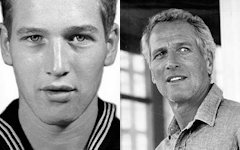 |
  |
Paul Newman US Navy Aviation Radioman Petty Officer Third Class 1943-1946 |
 Graduating high school in 1943,
Newman briefly attended college before enlisting in the US Navy Air Corps. He wanted to be a pilot, but he was told that he could never fly a plane as he
was colorblind. He ended up serving as a radio operator and a rear gunner in the Pacific aboard the USS Bunker Hill (CV-17). He flew with torpedo squadrons
VT-98, VT-99, VT-100, and later as a turret gunner in an Avenger torpedo bomber. Graduating high school in 1943,
Newman briefly attended college before enlisting in the US Navy Air Corps. He wanted to be a pilot, but he was told that he could never fly a plane as he
was colorblind. He ended up serving as a radio operator and a rear gunner in the Pacific aboard the USS Bunker Hill (CV-17). He flew with torpedo squadrons
VT-98, VT-99, VT-100, and later as a turret gunner in an Avenger torpedo bomber.He was awarded the Navy Good Conduct Medal, American Campaign Medal, Asiatic-Pacific Campaign Medal, World War II Victory Medal, Combat Aircrew Wings Badge, and the Honorable Discharge Pin. |
|||||||||||||
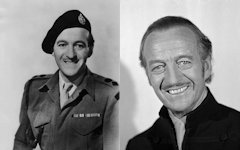 |
 |
David Niven British Army Lieutenant Colonel 1928-1933, 1939-1945 |
 In 1928, Niven attended the Royal Military
College, Sandhurst. He graduated in 1930 with a commission as a Second Lieutenant in the British Army. He was assigned to the Highland Light Infantry, with
which he served for two years in Malta and then for a few months in Dover. Niven grew tired of the peacetime army. Though promoted to Lieutenant on 1 January
1933, he saw no opportunity for further advancement. His ultimate decision to resign came after a lengthy lecture on machine guns, which was interfering with
his plans for dinner with a particularly attractive young lady. At the end of the lecture, the speaker (a Major General) asked if there were any questions.
Showing the typical rebelliousness of his early years, Niven asked, "Could you tell me the time, sir? I have to catch a train." After being placed under
close-arrest for this act of insubordination, Niven finished a bottle of whisky with the officer who was guarding him, Rhoddy Rose. With Rose's assistance,
Niven was allowed to escape from a first-floor window. He then headed for America. While crossing the Atlantic, Niven resigned his commission by telegram on
6 September 1933. In 1928, Niven attended the Royal Military
College, Sandhurst. He graduated in 1930 with a commission as a Second Lieutenant in the British Army. He was assigned to the Highland Light Infantry, with
which he served for two years in Malta and then for a few months in Dover. Niven grew tired of the peacetime army. Though promoted to Lieutenant on 1 January
1933, he saw no opportunity for further advancement. His ultimate decision to resign came after a lengthy lecture on machine guns, which was interfering with
his plans for dinner with a particularly attractive young lady. At the end of the lecture, the speaker (a Major General) asked if there were any questions.
Showing the typical rebelliousness of his early years, Niven asked, "Could you tell me the time, sir? I have to catch a train." After being placed under
close-arrest for this act of insubordination, Niven finished a bottle of whisky with the officer who was guarding him, Rhoddy Rose. With Rose's assistance,
Niven was allowed to escape from a first-floor window. He then headed for America. While crossing the Atlantic, Niven resigned his commission by telegram on
6 September 1933.The day after Britain declared war on Germany in 1939, Niven returned home and rejoined the British Army. He was alone among British stars in Hollywood in doing so; the British Embassy advised most actors to stay. Niven was recommissioned as a lieutenant into the Rifle Brigade (Prince Consort's Own) on 25 February 1940 and was assigned to a motor training battalion. He wanted something more exciting, however, and transferred to the Commandos. He was assigned to a training base at Inverailort House in the Western Highlands. Niven later claimed credit for bringing future Major General Sir Robert E. Laycock to the Commandos. Niven commanded "A" Squadron GHQ Liaison Regiment, better known as "Phantom". He was promoted to war-substantive captain on 18 August 1941. Niven also worked with the Army Film and Photographic Unit. His work included a small part in the deception operation that used minor actor M. E. Clifton James to impersonate General Sir Bernard Montgomery. On 14 March 1944, Niven was promoted War-Substantive Major (temporary Lieutenant Colonel). He took part in the Allied invasion of Normandy in June 1944, although he was sent to France several days after D-Day. He served in "Phantom", a secret reconnaissance and signals unit which located and reported enemy positions and kept rear commanders informed on changing battle lines. Niven was posted at one time to Chilham in Kent. He spoke little about his experience in the war, despite public interest in celebrities in combat and a reputation for storytelling. He was awarded the Legion of Merit, 1939-1945 Star, France and Germany Star, and the War Medal 1939-1945. |
|||||||||||||
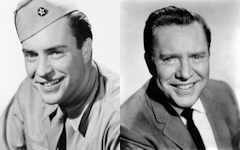 |
Edmond O'Brien US Army Air Forces Private First Class 1942-1944 |
 O'Brien served in the Special
Services Corps, 1st Motion Picture Unit making movies to entertain the troops. He then transferred to the Military Police Corps. O'Brien served in the Special
Services Corps, 1st Motion Picture Unit making movies to entertain the troops. He then transferred to the Military Police Corps.He was awarded the American Campaign Medal, World War II Victory Medal, Sharpshooter Marksman with Carbine Badge, and the Honorable Discharge Pin. |
||||||||||||||
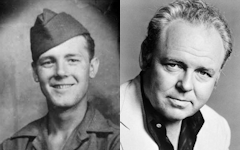 |
Caroll O’Connor US Merchant Marine Seaman 1942-1946 |
 In 1941, O'Connor enrolled at Wake
Forest University in North Carolina but dropped out when the United States entered World War II. During the war, he was rejected by the United States Navy and
enrolled in the United States Merchant Marine Academy for a short time. After leaving that institution, he became a merchant seaman and served in the United
States Merchant Marine during the war. In 1941, O'Connor enrolled at Wake
Forest University in North Carolina but dropped out when the United States entered World War II. During the war, he was rejected by the United States Navy and
enrolled in the United States Merchant Marine Academy for a short time. After leaving that institution, he became a merchant seaman and served in the United
States Merchant Marine during the war.He was awarded the Merchant Marine World War II Victory Medal. |
||||||||||||||
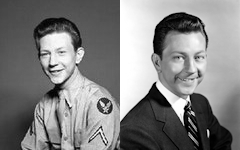 |
Donald O'Connor US Army Air Forces Private First Class 1943-1946 |
 O'Connor was drafted into the
Army Air Forces on his 18th birthday. As a young Hollywood star, he was assigned to the Special Services Corps, 1st Motion Picture Unit, making movies to entertain
the troops. O'Connor was drafted into the
Army Air Forces on his 18th birthday. As a young Hollywood star, he was assigned to the Special Services Corps, 1st Motion Picture Unit, making movies to entertain
the troops.He was awarded the Army Good Conduct Medal, American Campaign Medal, and the World War II Victory Medal. |
||||||||||||||
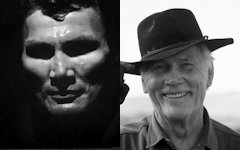 |
 |
Jack Palance US Army Air Forces Second Lieutenant 1942-1944
|
 In the late 1930s, Palance
started a professional boxing career fighting under the name Jack Brazzo. With the outbreak of World War II, Palance's boxing career ended and his military career
began as a member of the United States Army Air Forces. Palance's rugged face, which took many beatings in the boxing ring, was disfigured when he bailed out of a
burning B-24 Liberator bomber while on a training flight over southern Arizona, where he was a student pilot. Plastic surgeons repaired the damage as best they
could, but he was left with a distinctive, somewhat gaunt, look. After much reconstructive surgery, he was discharged in 1944. In the late 1930s, Palance
started a professional boxing career fighting under the name Jack Brazzo. With the outbreak of World War II, Palance's boxing career ended and his military career
began as a member of the United States Army Air Forces. Palance's rugged face, which took many beatings in the boxing ring, was disfigured when he bailed out of a
burning B-24 Liberator bomber while on a training flight over southern Arizona, where he was a student pilot. Plastic surgeons repaired the damage as best they
could, but he was left with a distinctive, somewhat gaunt, look. After much reconstructive surgery, he was discharged in 1944.He was awarded the American Campaign Medal, World War II Victory Medal, Pilot Badge, and the Sharpshooter Badge with Carbine and Pistol Bars. |
|||||||||||||
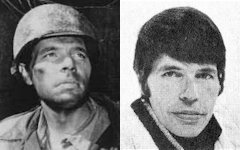 |
 |
Dick Peabody US Navy Electronic Technician's Mate Petty Officer First Class 1942-1945 |
 In 1942, at age 17, he joined the Navy.
He was transported to what is now Trinidad and Tobago in May of 1943 as a Radio Technician 2nd Class Petty officer which was later changed to Electronic
Technician's Mate. He then transferred to Naval Base Guantanamo Bay, Cuba, as Radio Technician 1st Class Petty Officer. He worked on the High Power Radio Communications Systems
at both location that were critical to the war in the Western Hemisphere. In 1942, at age 17, he joined the Navy.
He was transported to what is now Trinidad and Tobago in May of 1943 as a Radio Technician 2nd Class Petty officer which was later changed to Electronic
Technician's Mate. He then transferred to Naval Base Guantanamo Bay, Cuba, as Radio Technician 1st Class Petty Officer. He worked on the High Power Radio Communications Systems
at both location that were critical to the war in the Western Hemisphere.He was awarded the Navy Good Conduct Medal, American Campaign Medal, and the World War II Victory Medal. |
|||||||||||||
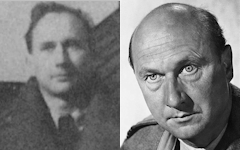 |
Donald Pleasence Royal Air Force 1940-1946 |
 After the attacks upon London
by the Luftwaffe, Pleasence volunteered with the Royal Air Force. He served as an aircraft wireless-operator with No. 166 Squadron in Bomber Command, with
which he flew almost sixty raids against the Axis over occupied Europe. On 31 August 1944, his Lancaster NE112 was shot down during an attack on Agenville
and he was captured and imprisoned in the German prisoner-of-war camp Stalag Luft I. After the war and his release, he was discharged from the RAF in 1946. After the attacks upon London
by the Luftwaffe, Pleasence volunteered with the Royal Air Force. He served as an aircraft wireless-operator with No. 166 Squadron in Bomber Command, with
which he flew almost sixty raids against the Axis over occupied Europe. On 31 August 1944, his Lancaster NE112 was shot down during an attack on Agenville
and he was captured and imprisoned in the German prisoner-of-war camp Stalag Luft I. After the war and his release, he was discharged from the RAF in 1946.He was awarded the 1939–1945 Star, Air Crew Europe Star, and the War Medal 1939–1945. |
||||||||||||||
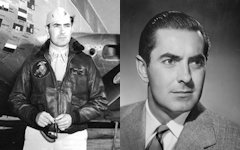 |
 |
Tyrone Power USMC Captain 1942-1946 |
 Tyrone Power was an actor that
could have received a direct commission and a cushy job, but he wanted to be a pilot. Due to his age and lack of education, he did not qualify to enter flight
training as a cadet. The only recourse open was to enter flight training as an officer. He was finishing the movie Crash Dive and had to delay entering the
Marine Corps as an enlisted man. Tyrone Power was an actor that
could have received a direct commission and a cushy job, but he wanted to be a pilot. Due to his age and lack of education, he did not qualify to enter flight
training as a cadet. The only recourse open was to enter flight training as an officer. He was finishing the movie Crash Dive and had to delay entering the
Marine Corps as an enlisted man.He finally earned his wings after working hard to finish. Retired Marine Corps flight instructor Jerry Taylor said that he trained Power as a pilot and that he was an excellent student, never forgot a procedure I showed him or anything I told him. Others said he was well respected since he acted like one of them instead of someone important. He was awarded the Combat Action Ribbon, Navy Presidential Unit Citation, Selected Marine Corps Reserve Medal, American Campaign Medal, Asiatic-Pacific Campaign Medal with 2 Bronze Battle Stars, World War II Victory Medal, Navy Occupation Service Medal, National Defense Service Medal, Philippine Liberation Ribbon, and the Naval Aviator Pilot Wings. |
|||||||||||||
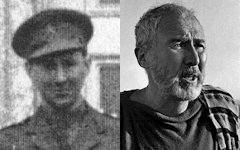 |
 |
Anthony Quayle British Army Major 1939-1945 |
 Quayle served as an area commander of the
Auxiliary Units in Northumberland. He also served as a liaison officer for the Special Operations Executive. Quayle served as an area commander of the
Auxiliary Units in Northumberland. He also served as a liaison officer for the Special Operations Executive. |
|||||||||||||
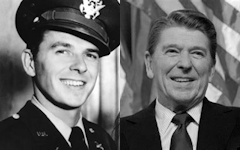 |
 |
Ronald Reagan US Army Air Forces Captain 1937-1953 |
 Ronald Wilson Reagan enrolled
in a series of home-study Army Extension Courses on 18 March 1935. After completing 14 of the courses, he enlisted in the Army Enlisted Reserve on 29 April 1937, as a
Private assigned to Troop B, 322nd Cavalry at Des Moines, Iowa. He was appointed Second Lieutenant in the Officers Reserve Corps of the Cavalry on 25 May 1937. On June
18 of that year Reagan, who had just moved to Los Angeles to begin his film career, accepted his Officer's Commission and was assigned to the 323rd Cavalry. Ronald Wilson Reagan enrolled
in a series of home-study Army Extension Courses on 18 March 1935. After completing 14 of the courses, he enlisted in the Army Enlisted Reserve on 29 April 1937, as a
Private assigned to Troop B, 322nd Cavalry at Des Moines, Iowa. He was appointed Second Lieutenant in the Officers Reserve Corps of the Cavalry on 25 May 1937. On June
18 of that year Reagan, who had just moved to Los Angeles to begin his film career, accepted his Officer's Commission and was assigned to the 323rd Cavalry.Lieutenant Reagan was ordered to active duty on 19 April 1942. Due to eyesight difficulties, he was classified for limited service only, which excluded him from serving overseas. His first assignment was at the San Francisco Port of Embarkation at Fort Mason, California, as liaison officer of the Port and Transportation Office. Upon the request of the Army Air Forces (AAF), he applied for a transfer from the Cavalry to the AAF on 15 May 1942; the transfer was approved on 9 June 1942. He was assigned to AAF Public Relations and subsequently to the 1st Motion Picture Unit in Culver City, California. Reagan was promoted to First Lieutenant on 14 January 1943 and was sent to the Provisional Task Force Show Unit of This Is The Army at Burbank, California. Following this duty, he returned to the 1st Motion Picture Unit, and on 22 July 1943 was promoted to Captain. In January 1944, Captain Reagan was ordered to temporary duty in New York City to participate in the opening of the sixth War Loan Drive. He was assigned to the 18th AAF Base Unit, Culver City, California on 14 November 1944, where he remained until the end of the war. He was recommended for promotion to Major on 2 February 1945, but this recommendation was disapproved on July 17 of that year. On 8 September 1945, he was ordered to report to Fort MacArthur, California, where he was separated from active duty on 9 December 1945. While on active duty with the 1st Motion Picture Unit and the 18th Army Air Forces Base Unit, Captain Reagan served as Personnel Officer, Post Adjutant, and Executive Officer. By the end of the war, his units had produced some 400 training films for the Army Air Forces. Reagan's Reserve Commission automatically terminated on 1 April 1953. However, he became Commander-in-Chief of all U.S. Armed Forces when he became President of the United States of America on 20 January 1981. He was awarded the Presidential Medal of Freedom, American Defense Service Medal, American Campaign Medal, World War II Victory Medal, Armed Forces Reserve Medal, and the British Order of the Bath. "If we look to the answer as to why, for so many years, we achieved so much, prospered as no other people on Earth, it was because here, in this land, we unleashed the energy and individual genius of man to a greater extent than has ever been done before. Freedom and the dignity of the individual have been more available and assured here than in any other place on Earth. The price for this freedom at times has been high, but we have never been unwilling to pay that price." - President Ronald Reagan in his first inaugural address |
|||||||||||||
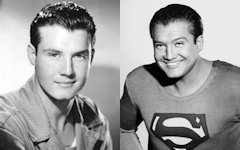 |
 |
George Reeves US Army Air Forces Sergeant 1943-1946 |
 Reeves enlisted in the Army Air
Forces and served in the Special Services Corps, Theatrical Unit. He appeared in several training films, including a movie on the dangers of venereal disease. While
stationed in New York, a theater director cast Reeves in a small role in the play Winged Victory. After the show's run on Broadway, he toured the country with the
production company. Reeves enlisted in the Army Air
Forces and served in the Special Services Corps, Theatrical Unit. He appeared in several training films, including a movie on the dangers of venereal disease. While
stationed in New York, a theater director cast Reeves in a small role in the play Winged Victory. After the show's run on Broadway, he toured the country with the
production company.He was awarded the American Campaign Medal, World War II Victory Medal, and the Honorable Discharge Pin. |
|||||||||||||
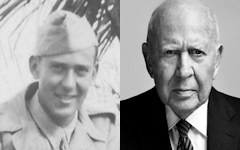 |
 |
Carl Reiner US Army Air Forces Corporal 1942-1946 |
 Reiner was drafted into
the Army Air Forces on October 27, 1942. He initially trained to be a radio operator. After spending three months in the hospital recovering from pneumonia, he
was sent to Georgetown University for ten months of training as a French interpreter. After completing language training in 1944, he was sent to Hawaii to work
as a teleprinter operator. The night before he was scheduled to ship out for an unknown assignment, he attended a production of Hamlet by the Special Services
entertainment unit. Following an audition before actor Major Maurice Evans, he was transferred to Special Services. Over the following two years, Reiner performed
around the Pacific theater, entertaining troops in Hawaii, Guam, Saipan, Tinian, and Iwo Jima until he was honorably discharged in 1946. Reiner was drafted into
the Army Air Forces on October 27, 1942. He initially trained to be a radio operator. After spending three months in the hospital recovering from pneumonia, he
was sent to Georgetown University for ten months of training as a French interpreter. After completing language training in 1944, he was sent to Hawaii to work
as a teleprinter operator. The night before he was scheduled to ship out for an unknown assignment, he attended a production of Hamlet by the Special Services
entertainment unit. Following an audition before actor Major Maurice Evans, he was transferred to Special Services. Over the following two years, Reiner performed
around the Pacific theater, entertaining troops in Hawaii, Guam, Saipan, Tinian, and Iwo Jima until he was honorably discharged in 1946.He was awarded the American Campaign Medal, and the World War II Victory Medal. |
|||||||||||||
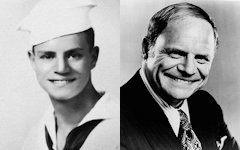 |
 |
Don Rickles US Navy Seaman First Class 1944-1946 |
 After graduating from high school, Rickles
enlisted in the US Navy and served for two years aboard the USS Cyrene (AGP-13) as a seaman first class. His ship departed Norfolk, Virginia on 10 November 1944,
transited the Panama Canal and arrived at Manus Province, in Papua New Guinea on 13 December to escort two squadrons of motor torpedo boats to Hollandia, New Guinea.
She then sailed on convoy duty to Leyte Gulf, Philippines, arriving on 1 January 1945. Cyrene then served as tender for PT Boasts, and on 17 January 1945, she became
the flagship for Commander, Motor Torpedo Boat Squadrons, 7th Fleet. After the war ended, she sailed from Samar, PI on 21 December 1945 and arrived at San Francisco
on 7 January 1946, reporting to the 12th Naval District for repair work in decommissioning small craft. Cyrene was decommissioned 2 July 1946 and delivered to the
War Shipping Administration for disposal the same day. Rickles was honorably discharged in 1946. After graduating from high school, Rickles
enlisted in the US Navy and served for two years aboard the USS Cyrene (AGP-13) as a seaman first class. His ship departed Norfolk, Virginia on 10 November 1944,
transited the Panama Canal and arrived at Manus Province, in Papua New Guinea on 13 December to escort two squadrons of motor torpedo boats to Hollandia, New Guinea.
She then sailed on convoy duty to Leyte Gulf, Philippines, arriving on 1 January 1945. Cyrene then served as tender for PT Boasts, and on 17 January 1945, she became
the flagship for Commander, Motor Torpedo Boat Squadrons, 7th Fleet. After the war ended, she sailed from Samar, PI on 21 December 1945 and arrived at San Francisco
on 7 January 1946, reporting to the 12th Naval District for repair work in decommissioning small craft. Cyrene was decommissioned 2 July 1946 and delivered to the
War Shipping Administration for disposal the same day. Rickles was honorably discharged in 1946.He was awarded the American Campaign Medal, Asiatic-Pacific Campaign Medal, World War II Victory Medal, Philippine Liberation Medal, and the Honorable Discharge Pin. |
|||||||||||||
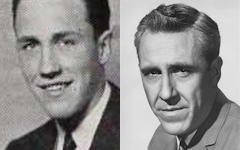 |
 |
Jason Robards US Navy Radioman Petty Officer First Class 1940-1946 |
 After high school, Robards decided to join
the Navy in 1940. He reported for service on 16 September, 1940. After enlisting, Robards went to Naval Training Station, San Diego, CA for Radioman training. In 1941,
he reported aboard the USS Northhampton (CA-26)on 26 March 1941 as Seaman Second Class. He was promoted on 1 August 1941 to Seaman First Class. On 26 November 1941 he
was transferred from the Northampton to Flag Allowance of Commander Cruiser Division 5 (CCD5) but still on the USS Northhampton. On 1 December 1941, he was promoted to
Radioman 3rd Class Petty Officer. (Flag Allowance is the Admiral's Staff and enlisted personnel that mans flag plot during OTC and condition watches, sifts through
intelligence files for battle information, stands communication (his job) and signal bridge watches, performs administration duties of the command, furnishes music
for honors and entertainment, serves the Admiral's mess and mans the Admiral's barge.) Despite contrary reports, Robards' ship was miles away from Pearl Harbor when
the Japanese attacked. On 7 December 1941, Northampton was at sea with the USS Enterprise task force. The next day, she entered Pearl Harbor to witness first hand
the devastation caused by Japan's surprise attack. After high school, Robards decided to join
the Navy in 1940. He reported for service on 16 September, 1940. After enlisting, Robards went to Naval Training Station, San Diego, CA for Radioman training. In 1941,
he reported aboard the USS Northhampton (CA-26)on 26 March 1941 as Seaman Second Class. He was promoted on 1 August 1941 to Seaman First Class. On 26 November 1941 he
was transferred from the Northampton to Flag Allowance of Commander Cruiser Division 5 (CCD5) but still on the USS Northhampton. On 1 December 1941, he was promoted to
Radioman 3rd Class Petty Officer. (Flag Allowance is the Admiral's Staff and enlisted personnel that mans flag plot during OTC and condition watches, sifts through
intelligence files for battle information, stands communication (his job) and signal bridge watches, performs administration duties of the command, furnishes music
for honors and entertainment, serves the Admiral's mess and mans the Admiral's barge.) Despite contrary reports, Robards' ship was miles away from Pearl Harbor when
the Japanese attacked. On 7 December 1941, Northampton was at sea with the USS Enterprise task force. The next day, she entered Pearl Harbor to witness first hand
the devastation caused by Japan's surprise attack.In 1942, Robards did see plenty of action throughout the war. The USS Northampton early wartime operations were primarily in the Hawaiian area, but in late January 1942 she went to the central Pacific, where on 1 February she bombarded Wotje, in the Marshall Islands. A second bombardment, of Wake Island, was delivered on 24 February. Northampton was unsuccessfully attacked by Japanese aircraft at that time. In March, she operated with the carrier task force that struck Marcus Island and the next month took part in the Doolittle Raid on Japan. She accompanied the USS Enterprise (CV-6) to the south Pacific in May 1942 and escorted her through the Battle of Midway in early June. The Northampton returned to the southern Pacific in August 1942 to participate in the Guadalcanal campaign. Serving for the next two months with carrier task forces, she was present when USS Wasp (CV-7) was sunk by a Japanese submarine on 15 September and accompanied the USS Hornet (CV-8) during the 26 October Battle of the Santa Cruz Islands. When that carrier was disabled by enemy torpedoes and bombs, Northampton tried to tow her out of danger, but had to abandon the Hornet to her fate after another air attack inflicted fatal damage. During November, Northampton joined a cruiser-destroyer surface action group. On the night of 30 November 1942, her task force intercepted several Japanese destroyers off Guadalcanal. The resulting Battle of Tassafaronga was a shattering experience for the U.S. Navy, which received further proof of the enemy's superiority in night gun and torpedo combat. Northampton was one of four US heavy cruisers hit by Japanese torpedoes. A serious fire amidships prevented damage control parties from controlling her flooding, and she sank stern-first three hours after she was hit. The ship was destroyed, and Robards survived by treading water near the wreckage for hours until a US destroyer either the USS Fletcher (DD-445) or USS Drayton (DD-366) rescued him. He was transferred to the USS Barnett (APA-5) on 3 December 1942 and transferred on 4 December to the USS President Hayes (APA-20) and again on 6 December, 1942 to Commander, Service Squadron, South Pacific Force (COMSERONSOPAC) from the USS President Hayes (APA-20). In 1943, he reported aboard the USS Honolulu (CL-48) on 12 March 1943 as a Radioman 2nd Class Petty Officer as part of the Flag Allowance for Cruiser Division 9 (CCD-9). Between March and July, Honolulu operated out of Espiritu Santo in early 1943 with Task Force 67 (TF 67) in an attempt to engage the "Tokyo Express". During May, she engaged in bombardments of New Georgia in the Solomons. Honolulu departed from Espiritu Santo on 28 June for more bombardments in the Solomons. After supporting the landings on New Georgia Island on 4 July, she opened fire on enemy ships in the Battle of Kula Gulf, knocking out one destroyer and assisting in the destruction of others. The battle-proven cruiser had another opportunity to confront the Japanese fleet on 13 July, in the Battle of Kolombangara. Shortly after midnight, contact was made with an enemy cruiser-destroyer force in "The Slot". At 0110, Honolulu opened fire on a Sendai-class light cruiser. After three salvos, the target burst into flames and was soon dead in the water. Honolulu shifted fire to an enemy destroyer, which was immediately hit and disappeared. At 0211, a torpedo struck the starboard side of Honolulu, blowing a hole in her hull. The task force then retired to Tulagi for temporary repairs, and then departed for the large naval base at Pearl Harbor. During the battle, the Japanese ships Jintsu and Gwin were sunk and the HMNZS Leander, the Honolulu, and the St. Louis (CL-49) were damaged. St. Louis took a torpedo which hit well forward and twisted her bow, but caused no serious casualties. Both the St Louis and the Honolulu arrived at Pearl Harbor for major repairs. They both then proceeded to the shipyard at Mare Island, near San Francisco, for more work till mid to late November. During this time in the US, Robards was transferred back and forth from the USS Honolulu and the USS St Louis. On 14 November 1943 the Flag Allowance was transferred to the USS Nashville (CL-43) then back to the USS St Louis on 26 November 1943 and then back to the USS Nashville on 30 November 1943. Then on 15 December 1943 back to the USS Honolulu. USS Honolulu arrived at Espiritu Santo on 11 December, CCD-9 Command Flag Allowance was transferred on the USS Honolulu on 15 December 1943. The Ship then resumed operations in the Solomons later that month. On 27 December, she engaged in the bombardment of an enemy barge, troop, and supply concentration on Bougainville Island. In the early months of 1944, the cruiser continued bombardments and patrols in the Solomon Islands. She screened the landings on Green Island on 13 February, before retiring from the Solomons to begin preparations for the Saipan and Guam operations in the Mariana Islands. In 1944, Honolulu took part in bombardments of the southeastern part of Saipan Island in early June as the Navy and Marines leaped across the Pacific. While bombarding Guam in mid-June, Honolulu was deployed northwest to intercept the Japanese fleet. She returned to Eniwetok Atoll on 28 June for replenishments, before providing support for the invasion of Guam. She remained on station for three weeks, performing great service with her accurate gunfire, before returning to Purvis Bay on Florida Island in the Solomons on 18 August. Honolulu steamed out on 6 September to provide fire support for the landings in the Palau Islands, such as at Peleliu Island and Anguar, remaining in this area during September unopposed by the Japanese fleet. America now had decisive command of the sea, and therefore nearly full freedom of operations. While Robards was onboard he was promoted to Radioman Petty Officer 1st Class on 1 June 1944. On 7 December 1944 the Flag Allowance was transferred to be onshore with Commander Destroyer Pacific Fleet (COMDESPAC). For the remainder of the war, US Navy Muster reports do show Jason Robards but it is reported that he remain on shore. He was discharged in early 1946. He participated in the Bombardment - Marshall and Gilbert Islands, Wake Island Raid, Marcus Island Raid, Doolittle B-25 Attack on Tokyo, Battle of Midway, Guadalcanal-Tulagi landings, Cape Esperance (Second Salvo), Battle of the Santa Cruz Islands, Tassafaronga (Fourth Salvo), Northern Solomon Islands Campaign, New Georgia Campaign, Battle of Kula Gulf, Battle of Kolombangara, Battle of Saipan, Battle of Guam, and the Battle of Peleliu. He was awarded the Navy Good Conduct Medal, American Defense Service Medal with Fleet Clasp, American Campaign Medal, Asiatic-Pacific Campaign Medal with 2 Silver Battle Stars (each counts as 5 Bronze Stars) and 2 Bronze Battle Stars, World War II Victory Medal, and the Honorable Discharge Pin. |
|||||||||||||
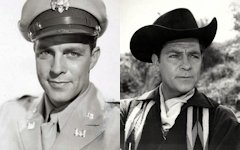 |
 |
Dale Robertson US Army First Lieutenant 1940-1945 |
 Robertson joined the Army in 1943 and was
sent to Ft. Riley for basic training as a cavalryman in Horse Detachment, Special Troops Battalion, 1st Cavalry Division. He was promoted to Corporal and served in
the 777th Tank Battalion in the Pacific Theater. In 1944 he was sent to Officer Candidate School in Ft. Knox, KY. He was commissioned as a Second Lieutenant and served
as an Engineering Officer and Platoon Leader, 2nd Platoon, C Company, 322nd Combat Engineers, 97th Infantry Division. His unit fought alongside infantry troops
in order to clear mines and build or repair what the Germans had blown up. An 88mm artillery shell exploded nearby and Robertson was wounded by the shrapnel. He
dressed his own wounds and continued the mission. Robertson joined the Army in 1943 and was
sent to Ft. Riley for basic training as a cavalryman in Horse Detachment, Special Troops Battalion, 1st Cavalry Division. He was promoted to Corporal and served in
the 777th Tank Battalion in the Pacific Theater. In 1944 he was sent to Officer Candidate School in Ft. Knox, KY. He was commissioned as a Second Lieutenant and served
as an Engineering Officer and Platoon Leader, 2nd Platoon, C Company, 322nd Combat Engineers, 97th Infantry Division. His unit fought alongside infantry troops
in order to clear mines and build or repair what the Germans had blown up. An 88mm artillery shell exploded nearby and Robertson was wounded by the shrapnel. He
dressed his own wounds and continued the mission.He was awarded the Silver Star, Bronze Star, Purple Heart with 1 Bronze Oak Leaf Cluster, American Defense Service Medal, American Campaign Medal, Asiatic-Pacific Campaign Medal with 1 Bronze Battle Star and 1 Bronze Arrowhead device, European-African-Middle Eastern Campaign Medal, World War II Victory Medal, and the Army of Occupation Medal. |
|||||||||||||
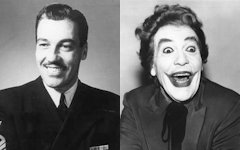 |
 |
Cesar Romero US Coast Guard Boatswain's Mate Chief Petty Officer 1943-1945 |
 Enlisted in the Coast Guard in 1942 and
reported aboard the USS Cavalier (APA-37). He saw action at Tinian and Saipan. Among his combat duties, he was the first powderman on the forward five-inch gun.
He made the rank of Chief Petty Officer before being discharged after the war. Enlisted in the Coast Guard in 1942 and
reported aboard the USS Cavalier (APA-37). He saw action at Tinian and Saipan. Among his combat duties, he was the first powderman on the forward five-inch gun.
He made the rank of Chief Petty Officer before being discharged after the war.He was awarded the American Campaign Medal, Asiatic-Pacific Campaign Medal with 4 Bronze Battle Stars, World War II Victory Medal, and the Honorable Discharge Pin. |
|||||||||||||
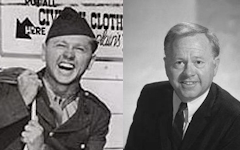 |
 |
Mickey Rooney US Army Private First Class 1944-1946 |
 When Rooney was first called for service, he
was declined due to high blood pressure. He was extremely upset and took measures to make sure he would be accepted at a later date. He spent the next 2 years
entertaining the troops at USO shows. He then tried again to enlist and was accepted in June 1944. He was sent to Fort Riley, KS for cavalry tactics. Within 2
weeks of training, he was promoted to squad leader. Someone whined that Rooney was only promoted due to his Hollywood celebrity status, Rooney called him out
and a fight broke out with the entire squad looking on. Rooney got the best of his opponent before the fight was broken up. The two made amends over a couple of
brews and no one ever questioned Rooney's patriotism or his punch. When Rooney was first called for service, he
was declined due to high blood pressure. He was extremely upset and took measures to make sure he would be accepted at a later date. He spent the next 2 years
entertaining the troops at USO shows. He then tried again to enlist and was accepted in June 1944. He was sent to Fort Riley, KS for cavalry tactics. Within 2
weeks of training, he was promoted to squad leader. Someone whined that Rooney was only promoted due to his Hollywood celebrity status, Rooney called him out
and a fight broke out with the entire squad looking on. Rooney got the best of his opponent before the fight was broken up. The two made amends over a couple of
brews and no one ever questioned Rooney's patriotism or his punch. In September 1944, he was sent to Alabama for chemical warfare training but before he could start, he was sent to the 6817th Special Services Unit because the USO performers refused to go to the front lines to entertain the troops. He was sent to New York to board the Queen Mary which was bound to for England. While onboard, he was assigned KP duty so no one would think the Special Services Unit was getting special treatment. The front lines were moving rapidly across Europe which made it very difficult to transport all the entertainers so the Army created 3-man "jeep shows" to entertain the troops in a combat zone. Their objective was to entertain the troops while also remaining soldiers in a combat zone. They ate c-rations along side the infantry and would go for weeks without showers. They were required to carry a rifle and on occasion, Rooney did have to engage the enemy. He was awarded the Bronze Star, Army Good Conduct Medal, American Campaign Medal, European-African-Middle Eastern Campaign Medal with 1 Bronze Battle Star, World War II Victory Medal, and the Honorable Discharge Pin. |
|||||||||||||
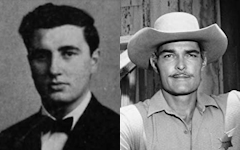 |
 |
John Russell USMC Second Lieutenant 1942-1944 |
 Russell joined the
US Marine Corps and was commissioned a 2nd Lieutenant in November 1942. He was assigned to the 6th Marine Regiment and served as an Intelligence Officer at
Guadalcanal in the Pacific Theater of Operations. After contracting malaria, he was discharged and returned home. Russell joined the
US Marine Corps and was commissioned a 2nd Lieutenant in November 1942. He was assigned to the 6th Marine Regiment and served as an Intelligence Officer at
Guadalcanal in the Pacific Theater of Operations. After contracting malaria, he was discharged and returned home.He was awarded the Combat Action Ribbon, Navy Presidential Unit Citation, American Campaign Medal, Asiatic-Pacific Campaign Medal, World War II Victory Medal, Pistol Sharpshooter Badge, and the Honorable Discharge Pin. |
|||||||||||||
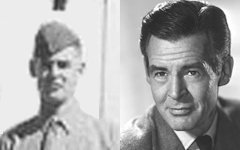 |
 |
Robert Ryan USMC Corporal 1944-1945 |
 Robert Ryan served in the
United States Marine Corps as a drill instructor (winning a boxing championship). Robert Ryan served in the
United States Marine Corps as a drill instructor (winning a boxing championship).He was awarded the American Campaign Medal, World War II Victory Medal, and the Honorable Discharge Pin. |
|||||||||||||
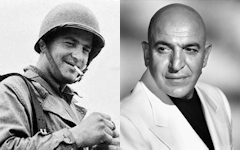 |
 |
Telly Savalas US Army Corporal 1941-1943 |
 Savalas joined the Army in 1941. He was
a member of Company C, 12th Medical Training Battalion, 4th Medical Training Regiment at Camp Pickett, Virginia. Although Telly received a Purple Heart for his
service in World War II, little is known about his time with the armed forces. He was released from the Army in 1943 after suffering serious injuries in a car
accident. While on authorized leave from Camp Pickett, Telly and eight friends were involved in a head-on collision. Telly sustained a broken pelvis, sprained ankle
and a concussion. He spent over a year in the hospital recovering. Savalas joined the Army in 1941. He was
a member of Company C, 12th Medical Training Battalion, 4th Medical Training Regiment at Camp Pickett, Virginia. Although Telly received a Purple Heart for his
service in World War II, little is known about his time with the armed forces. He was released from the Army in 1943 after suffering serious injuries in a car
accident. While on authorized leave from Camp Pickett, Telly and eight friends were involved in a head-on collision. Telly sustained a broken pelvis, sprained ankle
and a concussion. He spent over a year in the hospital recovering.He was awarded the Purple Heart, American Defense Service Medal, American Campaign Medal, European–African–Middle Eastern Campaign Medal, World War II Victory Medal, and the Honorable Discharge Pin. |
|||||||||||||
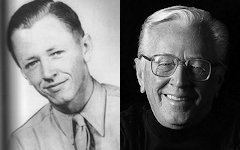 |
 |
Charles M. Schulz US Army Staff Sergeant 1943-1946
|
 Drafted into the Army in 1943 and was sent to
Fort Campbell, KY. Two years later he was shipped to Europe to fight with the 20th Armored Division. His unit spent the first month in training and saw combat
at the very end of the war. He served as a squad leader on a .50 cal machine gun team. Drafted into the Army in 1943 and was sent to
Fort Campbell, KY. Two years later he was shipped to Europe to fight with the 20th Armored Division. His unit spent the first month in training and saw combat
at the very end of the war. He served as a squad leader on a .50 cal machine gun team.He was awarded the Army Good Conduct Medal, American Campaign Medal, European-African-Middle Eastern Campaign Medal with 1 Bronze Battle Star, World War II Victory Medal, Army of Occupation Medal, Combat Infantryman Badge, and the Honorable Discharge Pin. |
|||||||||||||
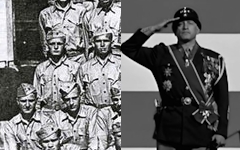 |
 |
George C. Scott USMC Sergeant 1945-1949 |
 Scott joined the Marines
in 1945. He was assigned to 8th and I Barracks in Washington, D.C. and his primary duty was serving as Honor Guard at military funerals at Arlington National
Cemetery. Scott joined the Marines
in 1945. He was assigned to 8th and I Barracks in Washington, D.C. and his primary duty was serving as Honor Guard at military funerals at Arlington National
Cemetery.He was awarded the Marine Corps Good Conduct Medal, American Campaign Medal, World War II Victory Medal, and the Honorable Discharge Pin. |
|||||||||||||
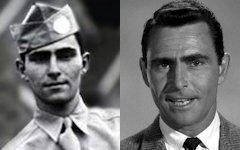 |
 |
Rod Serling US Army Technician Fourth Grade 1943-1946
|
 On the day Serling graduated high school,
he enlisted in the US Army as a Paratrooper and Demolition Specialist with the 511th Parachute Infantry Regiment, 11th Airborne Division. He served in the Pacific
Theater. His unit fought 17,000 Japanese troops for a month to get control of Manila. He was seriously wounded in the wrist and knee during combat. During his
service in World War II, he watched as his best friend was crushed to death by a heavy supply crate dropped by a parachute onto the field. He fought at the
Central Pacific Campaign, Leyte Campaign, Luzon Campaign, Battle for Manila, and the Southern Philippines Campaign. On the day Serling graduated high school,
he enlisted in the US Army as a Paratrooper and Demolition Specialist with the 511th Parachute Infantry Regiment, 11th Airborne Division. He served in the Pacific
Theater. His unit fought 17,000 Japanese troops for a month to get control of Manila. He was seriously wounded in the wrist and knee during combat. During his
service in World War II, he watched as his best friend was crushed to death by a heavy supply crate dropped by a parachute onto the field. He fought at the
Central Pacific Campaign, Leyte Campaign, Luzon Campaign, Battle for Manila, and the Southern Philippines Campaign.He was awarded the Bronze Star, Purple Heart, Army Presidential Unit Citation, Army Good Conduct Medal, American Campaign Medal, Asiatic-Pacific Campaign Medal with 4 Bronze Battle Stars and 1 Bronze Arrowhead device, World War II Victory Medal, Army of Occupation Medal, Philippine Presidential Unit Citation, Philippine Liberation Medal, Combat Infantry Badge, Airborne Glider Badge, Basic Parachutist Badge with 1 Bronze Star (Combat Jump), and the Honorable Discharge Pin. |
|||||||||||||
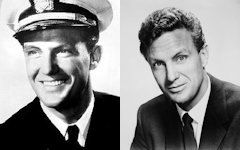 |
 |
Robert Stack US Navy Lieutenant 1942-1945
|
 Because of his expertise as an Olympic
champion skeet shooter, (U.S. 20-gauge champion skeet marksman before WWII, he holds the record for more than 350 consecutive skeet hits), when Stack decided to join
the Navy in 1942 and was commissioned as an Ensign. He was assigned to teach anti-aircraft gunnery at the Gunnery Instructors School. He was then sent to Aerial
Gunnery Instructors School as an instructor and promoted to Lieutenant JG. During his service, he earned numerous medals and commendations, particularly for his
skill at sharp-shooting. He was a top-notch air-to-air gunnery instructor. In 1944, he was promoted to Lieutenant and served aboard the USS Hancock (CVA-19) and
in 1945 he served aboard the USS Sitkoh Bay (CVE-86). Because of his expertise as an Olympic
champion skeet shooter, (U.S. 20-gauge champion skeet marksman before WWII, he holds the record for more than 350 consecutive skeet hits), when Stack decided to join
the Navy in 1942 and was commissioned as an Ensign. He was assigned to teach anti-aircraft gunnery at the Gunnery Instructors School. He was then sent to Aerial
Gunnery Instructors School as an instructor and promoted to Lieutenant JG. During his service, he earned numerous medals and commendations, particularly for his
skill at sharp-shooting. He was a top-notch air-to-air gunnery instructor. In 1944, he was promoted to Lieutenant and served aboard the USS Hancock (CVA-19) and
in 1945 he served aboard the USS Sitkoh Bay (CVE-86).He was awarded the Navy and Marine Corps Commendation Medal, American Campaign Medal, Asiatic-Pacific Campaign Medal, World War II Victory Medal, Distinguished Marksman Badge Rifle, and the Distinguished Marksman Badge Pistol. |
|||||||||||||
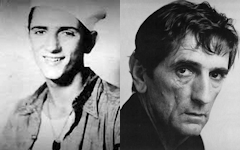 |
 |
Harry Dean Stanton US Navy Ships Cook Petty Officer Third Class 1944-1946 |
 Served as a ships cook on the
USS (LST-970) from 1944-1945 and was at the Battle of Okinawa. He also served aboard the USS (LST-321) from 1945-1946. Served as a ships cook on the
USS (LST-970) from 1944-1945 and was at the Battle of Okinawa. He also served aboard the USS (LST-321) from 1945-1946.He was awarded the American Campaign Medal, Asiatic–Pacific Campaign Medal, World War II Victory Medal, and the Honorable Discharge Pin. |
|||||||||||||
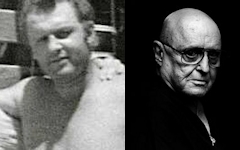 |
 |
Rod Steiger US Navy Torpedoman Petty Officer Third Class 1942-1945 |
 Steiger dropped out of high school to join the US Navy.
He served as a Torpedoman aboard the USS Benham (DD-397) from 1942-1944 in the South Pacific. He saw action at the Battle of Midway and the Guadalcanal Campaign. He
was then stationed aboard the USS Taussig (DD-746) where he saw action during the Luzon Campaign, the Iwo Jima Operation, and the Okinawa Gunto Operation. Steiger dropped out of high school to join the US Navy.
He served as a Torpedoman aboard the USS Benham (DD-397) from 1942-1944 in the South Pacific. He saw action at the Battle of Midway and the Guadalcanal Campaign. He
was then stationed aboard the USS Taussig (DD-746) where he saw action during the Luzon Campaign, the Iwo Jima Operation, and the Okinawa Gunto Operation.He was awarded the Combat Action Ribbon, American Campaign Medal, Asiatic-Pacific Campaign Medal with 4 Bronze Battle Stars, World War II Victory Medal, Philippine Liberation Medal, and the Honorable Discharge Pin. |
|||||||||||||
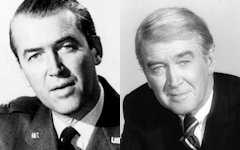 |
 |
Jimmy Stewart US Army Air Forces Major General 1941-1968 |
 The Stewart family had deep
military roots as both grandfathers had fought in the Civil War, and his father had served during both the Spanish-American War and World War I. Since Stewart
considered his father to be the biggest influence on his life, it was not surprising that when another war eventually came, he too served. Unlike his family's
previous infantry service, Stewart chose to become a military flyer. The Stewart family had deep
military roots as both grandfathers had fought in the Civil War, and his father had served during both the Spanish-American War and World War I. Since Stewart
considered his father to be the biggest influence on his life, it was not surprising that when another war eventually came, he too served. Unlike his family's
previous infantry service, Stewart chose to become a military flyer.Nearly two years before the December 1941 attack on Pearl Harbor, Stewart had become a private pilot and had accumulated over 400 hours of flying time. Along with musician/composer Hoagy Carmichael, seeing the need for trained war pilots, Stewart teamed with other Hollywood moguls and put their own money into creating a flying school in Glendale, Arizona which they named Thunderbird Field. This airfield trained more than 200,000 pilots during the War, became the origin of the Flying Thunderbirds, and is now the home of Thunderbird School of Global Management. Later in 1940, Stewart was drafted into the Army Air Corps but was rejected due to a weight problem. The USAAC had strict height and weight requirements for new recruits and Stewart was five pounds under the standard. To get up to 148 pounds he sought out the help of Metro-Goldwyn-Mayer's muscle man, Don Loomis, who was legendary for his ability to add or subtract pounds in his studio gymnasium. Stewart subsequently attempted to enlist in the United States Army Air Corps but still came in under the weight requirement although he persuaded the AAF enlistment officer to run new tests, this time passing the weigh-in, with the result that Stewart successfully enlisted in the Army in March 1941. He became the first major American movie star to wear a military uniform in World War II. Since the United States had not entered the conflict and due to the Army's unwillingness to put celebrities on the front, Stewart was initially held back from combat duty, although he enlisted as a private, he earned a commission as a Second Lieutenant and completed pilot training. He was subsequently stationed in Albuquerque, NM, becoming an instructor pilot for the B-17 Flying Fortress. The only public appearances after he went into flight school were limited engagements scheduled by the Air Corps. Stewart appeared several times on network radio with Edgar Bergen and Charlie McCarthy. Shortly after Pearl Harbor, he performed with Orson Welles, Edward G. Robinson, Walter Huston and Lionel Barrymore in an all-network radio program called We Hold These Truths, dedicated to the 150th anniversary of the Bill of Rights. But mostly, Stewart's days and nights were spent preparing for his upcoming flight tests, ground school and academic examinations for his commission. For the thirty-six-year-old Stewart, combat duty seemed far away and unreachable, and he had no clear plans for the future. But then a rumor that Stewart would be taken off flying status and assigned to making training films or selling bonds called for his immediate and decisive action, because what he dreaded most was the hope-shattering specter of a dead end. So he appealed to his commander, a pre-war aviator, who understood the situation and reassigned him to a unit going overseas. In August 1943 he was finally assigned to the 445th Bombardment Group in Sioux City, Iowa, first as Operations Officer of the 703rd Bombardment Squadron and then its commander. In December, the 445th Bombardment Group flew its B-24 Liberator bombers to RAF Tibenham, England and immediately began combat operations. While flying missions over Germany, Stewart was promoted to Major. In March 1944, he was transferred as group operations officer to the 453rd Bombardment Group, a new B-24 unit that had been experiencing difficulties. As a means to inspire his new group, Stewart flew as command pilot in the lead B-24 on numerous missions deep into Nazi-occupied Europe. These missions went uncounted at Stewart's orders. His "official" total is listed as 20 and are limited to those with the 445th. In 1944, he twice received the Distinguished Flying Cross for actions in combat and was awarded the Croix de Guerre. He also received the Air Medal with three oak leaf clusters. In July 1944, after flying 20 combat missions, Stewart was made chief of staff of the 2nd Combat Bombardment Wing of the Eighth Air Force. Before the war ended, he was promoted to colonel, one of only a few Americans to rise from private to colonel in four years. At the beginning of June 1945, Stewart was the presiding officer of the Court-Martial of a pilot and navigator who were charged with dereliction of duty when they accidentally bombed the Swiss city of Zurich the previous March - the first instance of U.S. personnel being tried over an attack on a neutral country. The Court acquitted the accused. Stewart continued to play an active role in the United States Air Force Reserve after the war, achieving the rank of Brigadier General on 23 July 1959. Stewart did not often talk of his wartime service, perhaps due to his desire to be seen as a regular soldier doing his duty instead of as a celebrity. He did appear on the TV series, The World At War to discuss the 14 October 1943 bombing mission to Schweinfurt, which was the center of the German ball bearing manufacturing industry. This mission is known in USAF history as Black Thursday due to the incredibly high casualties it sustained; in total 60 aircraft were lost out of 291 dispatched, as the raid consisting entirely of B17s was unescorted all the way to Schweinfurt and back due to the current escort aircraft available lacking the range. Fittingly, he was identified only as "James Stewart, Squadron Commander" in the documentary. In 1966, Brigadier General James Stewart rode along as an observer on a B-52 Stratofortress bombing run during the Vietnam War; he also flew combat duty missions during that conflict. At the time of his B-52 mission, he refused the release of any publicity regarding his participation as he did not want it treated as a stunt, but as part of his job as an officer in the Air Force Reserve. He served as Air Force Reserve commander of Dobbins Air Reserve Base in the early 1950s and after 27 years of service, Stewart retired from the Air Force on 31 May 1968. He was awarded the Air Force Distinguished Service Medal, Distinguished Flying Cross with 1 Oak Leaf Cluster, Air Medal with 3 Oak Leaf Clusters, Army Commendation Medal, Army Presidential Unit Citation, Presidential Medal of Freedom, American Defense Service Medal, American Campaign Medal, European-African-Middle Eastern Campaign Medal with 3 Bronze Battle Stars, World War II Victory Medal, National Defense Service Medal, Air Force Longevity Award, Armed Forces Reserve Medal with Silver Hourglass device (20 years of service), French Croix de Guerre, and the Aviator Command Badge. |
|||||||||||||
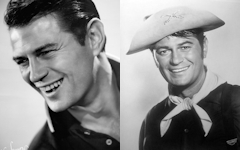 |
 |
Larry Storch US Navy Seaman First Class 1942-1946 |
 Storch served aboard the USS Proteus
(AS-19) as a Seaman First Class. He served with Tony Curtis and became very good friends. Storch served aboard the USS Proteus
(AS-19) as a Seaman First Class. He served with Tony Curtis and became very good friends.He was awarded the American Campaign Medal, and the World War II Victory Medal. |
|||||||||||||
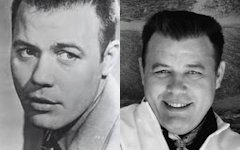 |
 |
Frank Sutton US Army Sergeant 1943-1946 |
 Sutton tried to enlist in every branch
of the armed forces but was rejected because of his color-blindness. Finally the the Army accepted him in 1943. He was assigned to a Joint Assault Signal Company,
composed of Army and Navy men. Within 18 months, he took part in 14 landings in the Pacific, including Leyte, Luzon, Bataan and Corregidor. When the war ended, he
was sent to join the occupation forces in Korea, where he wrote, directed and produced The Military Government Hour, a radio propaganda program. Sutton tried to enlist in every branch
of the armed forces but was rejected because of his color-blindness. Finally the the Army accepted him in 1943. He was assigned to a Joint Assault Signal Company,
composed of Army and Navy men. Within 18 months, he took part in 14 landings in the Pacific, including Leyte, Luzon, Bataan and Corregidor. When the war ended, he
was sent to join the occupation forces in Korea, where he wrote, directed and produced The Military Government Hour, a radio propaganda program.He was awarded the Bronze Star, Purple Heart, Army Good Conduct Medal, American Campaign Medal, Asiatic-Pacific Campaign Medal with 2 Bronze Battle Stars, World War II Victory Medal, Army of Occupation Medal, Philippine Presidential Unit Citation, Philippine Liberation Medal, and the Honorable Discharge Pin. |
|||||||||||||
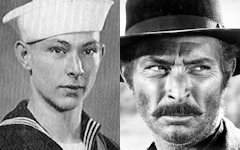 |
 |
Lee Van Cleef US Navy Sonarman Petty Officer First Class 1942-1946 |
 Van Cleef’s first love was the sea; he
volunteered as both an air warden and plane spotter in high school and enlisted in the U.S. Navy after graduating at age 17 in a compressed high school course in
1942. He enter service on Oct 16, 1942 and went to Sonarman School and graduated as a Sonarman, 3rd Class Petty Officer. He reported to his first vessel, a
subchaser with no name called USS SC-681 from March 15, 1943 to January 16, 1944. During his time on board he was promoted to 2nd Class Petty Officer. The
SC-681 patrolled the Caribbean in search of German U-Boats. Van Cleef’s first love was the sea; he
volunteered as both an air warden and plane spotter in high school and enlisted in the U.S. Navy after graduating at age 17 in a compressed high school course in
1942. He enter service on Oct 16, 1942 and went to Sonarman School and graduated as a Sonarman, 3rd Class Petty Officer. He reported to his first vessel, a
subchaser with no name called USS SC-681 from March 15, 1943 to January 16, 1944. During his time on board he was promoted to 2nd Class Petty Officer. The
SC-681 patrolled the Caribbean in search of German U-Boats.He went for more training at Fleet Sound School, Key West, FL, for a few weeks and was then transferred to Savannah, GA to be part of the pre-commissioning crew of a new ship. He was officially listed on the Commissioning Muster Report of the USS Incredible (AM-249) on April 17, 1944. USS Incredible, a 530-ton Admirable class minesweeper built at Savannah, Georgia, was commissioned in April 1944. She went to the Mediterranean Sea a few months later, where she participated in the Southern France invasion and subsequent operations. On 10 September 1944, she helped defeat an attack on Allied warships by German torpedoes. Incredible carried out mine sweeping duties in the Black Sea during the first two months of 1945. Returning to the U.S. in May, she transferred to the Pacific the following July and swept mines in the East China Sea and Ryukyus during the months following Japan's surrender. Lee was promoted to Petty Officer First Class while on board. He was discharged on February 20, 1946 as draw down of forces after of the war. On December 7, 1944, he wrote the following letter home. “We were along the coast and had our new mascot aboard. It was a fairly heavy sea (and cold water, I might add). Our mascot happens to be a spaniel of some sort. We call the water-loving hound 'Rusty'. Well, Rusty was out on the fantail this day and a wave came along, washing her overboard. We had to get permission to break formation and go back for her. That took us about 15 minutes until we finally found her. I was up on the bridge at the time, smoking my pipe. Well, I shed the knife I had on and my shoes, and yelled up for permission to go after her. 'Permission granted.' So I dove off the bridge. When I hit the water, I heard something snap in my mouth. That happened to be my pipe while diving about 30 feet. I don't know how my teeth escaped breaking. Luck, I call it. However, I got Rusty all right. She was swimming to beat everything. Quite a current too. They threw us a life ring and pulled us aboard. Yesterday I was out on the fantail and the sea was rushing up on the deck. Rusty came up and snuggled around my legs. I guess that swim was worth my favorite pipe.” He was awarded the Navy Good Conduct Medal, American Campaign Medal, European-African-Middle Eastern Campaign Medal with 1 Bronze Battle Star, Asiatic-Pacific Campaign Medal, World War II Victory Medal, and the Honorable Discharge Pin. |
|||||||||||||
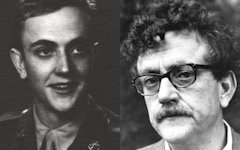 |
Kurt Vonnegut US Army - POW Private 1943-1945 |
 Joined the Army in 1942 and was
trained to be a mechanical engineer. He was then sent to Europe as an Infantry Battalion Scout in the 106th Infantry Division. During the Battle of the Bulge
he was captured and sent to Dresden. During the day he worked in a liquid vitamin factory. For 3 days, the Allies firebombed the city completely destroying it.
The POWs survived hiding in the in an underground meat locker of a slaughterhouse. When the bombing stopped, the prisoners were forced to help dig out the
bodies from the rubble. Eventually, the city was overrun by Soviet troops and Vonnegut was freed. Joined the Army in 1942 and was
trained to be a mechanical engineer. He was then sent to Europe as an Infantry Battalion Scout in the 106th Infantry Division. During the Battle of the Bulge
he was captured and sent to Dresden. During the day he worked in a liquid vitamin factory. For 3 days, the Allies firebombed the city completely destroying it.
The POWs survived hiding in the in an underground meat locker of a slaughterhouse. When the bombing stopped, the prisoners were forced to help dig out the
bodies from the rubble. Eventually, the city was overrun by Soviet troops and Vonnegut was freed.He was awarded the Purple Heart, Prisoner of War Medal, American Campaign Medal, European-African-Middle Eastern Campaign Medal, and the World War II Victory Medal. |
||||||||||||||
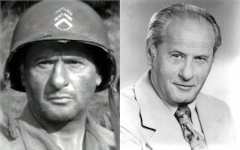 |
 |
Eli Wallach US Army Captain 1940-1945 |
 Wallach served as a staff sergeant
in Hawaii in a military hospital. He was soon sent to Officer Candidate School (OCS) in Abilene, Texas to train as a medical administrative officer. He graduated
as a Second Lieutenant and was sent to Madison Barracks in upstate New York. He was promptly shipped to Casablanca and, later in the war, to France. It was there
that a superior discovered his acting history and asked him to form a show for the patients. He and other members from his unit wrote a play called Is This the
Army?, which was inspired by Irving Berlin's This is the Army. In the comedic play, Wallach and the other men clowned around as various dictators, with Wallach
portraying Adolf Hitler, the leader of Nazi Germany. Wallach served as a staff sergeant
in Hawaii in a military hospital. He was soon sent to Officer Candidate School (OCS) in Abilene, Texas to train as a medical administrative officer. He graduated
as a Second Lieutenant and was sent to Madison Barracks in upstate New York. He was promptly shipped to Casablanca and, later in the war, to France. It was there
that a superior discovered his acting history and asked him to form a show for the patients. He and other members from his unit wrote a play called Is This the
Army?, which was inspired by Irving Berlin's This is the Army. In the comedic play, Wallach and the other men clowned around as various dictators, with Wallach
portraying Adolf Hitler, the leader of Nazi Germany.He was awarded the Army Good Conduct Medal, American Defense Service Medal, American Campaign Medal, Asiatic–Pacific Campaign Medal, European–African–Middle Eastern Campaign Medal, World War II Victory Medal, and the Honorable Discharge Pin. |
|||||||||||||
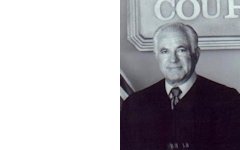 |
 |
Joseph Wapner US Army First Lieutenant 1942-1946
|
 Served in the South Pacific in the
132nd Infantry Division. He fought at the Battle of Mount Austen, Guadalcanal Campaign, Northern Solomons Campaign, and the Southern Philippines Campaign. Served in the South Pacific in the
132nd Infantry Division. He fought at the Battle of Mount Austen, Guadalcanal Campaign, Northern Solomons Campaign, and the Southern Philippines Campaign.
He was awarded the Bronze Star, Purple Heart, American Campaign Medal, Asiatic-Pacific Campaign Medal with 3 Bronze Battle Stars and 1 Bronze Arrowhead device, World War II Victory Medal, Philippine Liberation Medal, Philippine Presidential Unit Citation, Combat Infantryman Badge, and the Honorable Discharge Pin. |
|||||||||||||
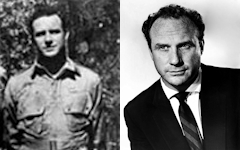 |
 |
Jack Warden US Army Staff Sergeant 1938-1945 |
 Warden joined the United States Navy in
1938. He was stationed in China for three years as a watchman with the Yangtze River Patrol aboard the USS Oahu (PR-6), a river gunboat. In 1941, he joined the
United States Merchant Marine but, quickly tiring of the long convoy runs, he switched to the United States Army in 1942. He served as a paratrooper in the
501st Parachute Infantry Regiment, with the elite 101st Airborne Division. In 1944, on the eve of the D-Day invasion, Warden shattered his leg by landing on a fence
during a night-time practice jump in England. After almost six months in the hospital, he recovered enough to participate in the Battle of the Bulge in 1944 and the
Siege of Bastogne. Warden joined the United States Navy in
1938. He was stationed in China for three years as a watchman with the Yangtze River Patrol aboard the USS Oahu (PR-6), a river gunboat. In 1941, he joined the
United States Merchant Marine but, quickly tiring of the long convoy runs, he switched to the United States Army in 1942. He served as a paratrooper in the
501st Parachute Infantry Regiment, with the elite 101st Airborne Division. In 1944, on the eve of the D-Day invasion, Warden shattered his leg by landing on a fence
during a night-time practice jump in England. After almost six months in the hospital, he recovered enough to participate in the Battle of the Bulge in 1944 and the
Siege of Bastogne.He was awarded the Bronze Star with Bronze V device, Purple Heart, Army Good Conduct Medal, Navy Good Conduct Medal, Navy Expeditionary Medal, China Service Medal, American Defense Service Medal, American Campaign Medal, European-African-Middle Eastern Campaign Medal with 1 Bronze Battle Star, World War II Victory Medal, Army of Occupation Medal, Yangtze Service Medal, Combat Infantryman Badge, Basic Parachutist Badge, and the Expert Marksman with Rifle Badge. |
|||||||||||||
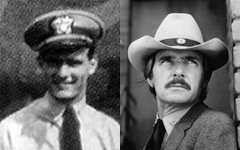 |
 |
Dennis Weaver US Navy Ensign 1943-1945 |
 Weaver joined the Naval Air Corps in
1943 and was entered into the V-5 Flight Training Program. While he was stationed at the University of Colorado at Boulder, Weaver learned to fly a Piper Cub.
On a perfect, clear day, as Weaver was taking off to fly his first solo along the Flatirons, his instructor told him, "You're on your own, kid, and don't
forget to spin." But as he attempted the maneuver at 6,000 feet, the plane started spinning out of control, heading right for the brown fields below.
"Overlapping thoughts of terror raced through my mind. ... Am I going to eat it on my first solo flight? Should I bail out? Will I get washed out? Will my damn
parachute work?" Weaver wrote later. Miraculously, the plane leveled out and a wrung-out Weaver managed to take the plane back to the airport. On shaking legs,
he passed the flight board to find his plane, number 23, marked with a warning, "Do not spin plane 23!" Weaver joined the Naval Air Corps in
1943 and was entered into the V-5 Flight Training Program. While he was stationed at the University of Colorado at Boulder, Weaver learned to fly a Piper Cub.
On a perfect, clear day, as Weaver was taking off to fly his first solo along the Flatirons, his instructor told him, "You're on your own, kid, and don't
forget to spin." But as he attempted the maneuver at 6,000 feet, the plane started spinning out of control, heading right for the brown fields below.
"Overlapping thoughts of terror raced through my mind. ... Am I going to eat it on my first solo flight? Should I bail out? Will I get washed out? Will my damn
parachute work?" Weaver wrote later. Miraculously, the plane leveled out and a wrung-out Weaver managed to take the plane back to the airport. On shaking legs,
he passed the flight board to find his plane, number 23, marked with a warning, "Do not spin plane 23!"After Weaver had pre-flight training in Oakland and primary training in Livermore, CA, he got his wings in Corpus Christi, TX. He was next stationed at Opa-locka Naval Air Station, near Miami, FL where he and his fellow pilots would stage mock dogfights to pass the time. He was making a dive on one of his buddies when he nearly ended crashed. "I went screaming past him," he wrote. "I was looking to see where he was, so he wouldn't get on my tail, when suddenly something made me turn around and look straight ahead. Holy cow, there was this pink stucco house. It was about two seconds away, and I was headed right for it! You never saw anybody jerk a stick back so fast—I damned near broke it! The nose of the F-4F arched skyward as it screamed past the pink house, missing it by a whisker." While Weaver was still at Opa-locka, he spent another afternoon making touch-and-go landings to simulate a carrier landing. As he came down for a landing in the F-4F, the manual landing gear folded like a tent, forcing Weaver into a screaming, fiery, gearless landing in an aircraft with its fuel tank in its belly. "It felt much like a horse when it steps in a gopher hole and crumples to its knees," he wrote. "I thought I was dead for sure. ... All I could think while my plane was skidding down the runway was, 'I've got to leave this baby as quickly as I can before I'm engulfed in flames.'" "I flew the Grumman F4F Wildcat, but I never got overseas," he says. "I fought the battles of Baffin Bay, Alameda and Opa-Locka. I had orders to go overseas but then they dropped the bomb and the war was over." When asked about his role in the war, Weaver said, "It wasn't much, but it sure was interesting." He was awarded the American Campaign Medal, World War II Victory Medal, and the Honorable Discharge Pin. |
|||||||||||||
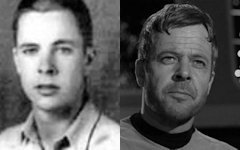 |
 |
William Windom US Army Technician Fifth Grade 1943-1946
|
 Windom enlisted in the Army on 19
February 1943. He served with B Company, 1st Battalion, 508th Parachute Regiment, 82nd Airborne Division in the European Theater. He was part of the
occupation forces in Frankfurt-am-Main at the end of the War. Windom enlisted in the Army on 19
February 1943. He served with B Company, 1st Battalion, 508th Parachute Regiment, 82nd Airborne Division in the European Theater. He was part of the
occupation forces in Frankfurt-am-Main at the end of the War.He was awarded the Bronze Star, Presidential Unit Citation, Army Good Conduct Medal, American Campaign Medal, European-African-Middle Eastern Campaign Medal with 1 Bronze Battle Star and 1 Bronze Arrowhead device, World War II Victory Medal, Army of Occupation Medal, Belgium Croix de Guerre, Combat Infantryman Badge, Basic Parachutist Badge with 2 Bronze Stars (Combat Jumps), Belgian Fourragere, and the Honorable Discharge Pin. |
|||||||||||||
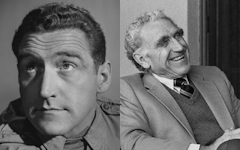 |
 |
James Whitmore USMC Sergeant 1942-1946 |
 Attached to the Marine Barracks,
Rodman Naval Station, Panama and saw combat at the Battle of Eastern Solomon's (Stewart Island) in 1942. Attached to the Marine Barracks,
Rodman Naval Station, Panama and saw combat at the Battle of Eastern Solomon's (Stewart Island) in 1942.He was awarded the Combat Action Ribbon, Marine Corps Good Conduct Medal, Asiatic-Pacific Campaign Medal, World War II Victory Medal, and the Honorable Discharge Pin. James Whitmore was buried at sea. |
|||||||||||||
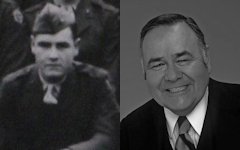 |
 |
Jonathan Winters USMC Corporal 1943-1946 |
 At age 17, Winters dropped out of high school
to join the Marine Corps. He was attached to MARDET, USS Bonhomme Richard (CVA-31) from 1944-1945. He spent 2 1/2 years in the Pacific Theater and fought at the Battle
of Okinawa. Later in life, he was quoted, "I've always been proud of being a Marine. I won't hesitate to defend the Corps." At age 17, Winters dropped out of high school
to join the Marine Corps. He was attached to MARDET, USS Bonhomme Richard (CVA-31) from 1944-1945. He spent 2 1/2 years in the Pacific Theater and fought at the Battle
of Okinawa. Later in life, he was quoted, "I've always been proud of being a Marine. I won't hesitate to defend the Corps."He was awarded the Combat Action Ribbon, Navy Unit Commendation, Marine Corps Good Conduct Medal, American Campaign Medal, Asiatic-Pacific Campaign Medal with 1 Bronze Battle Star, World War II Victory Medal, Navy Occupation Service Medal, and the Honorable Discharge Pin. |
|||||||||||||
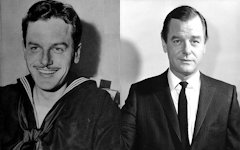 |
 |
Gig Young US Coast Guard Hospital Corpsman Petty Officer Third Class 1941-1945 |
 Born Byron Elsworth
Barr, Gig Young joined the Coast Guard in 1942 and served as a Hospital Corpsman in the Pacific. Born Byron Elsworth
Barr, Gig Young joined the Coast Guard in 1942 and served as a Hospital Corpsman in the Pacific.He was awarded the US Coast Guard Good Conduct Medal, American Campaign Medal, World War II Victory Medal, and the Honorable Discharge Pin. |
|||||||||||||





